EVERY DROP MATTERS


Pumps and Circulators
Domestic-scale anaerobic digestion
Ishani Banerjee
EHPA slams MEPs vote on F-Gas
Thomas Nowak

EFCA green digital built environment

Sue Arundale


GCP Europe EuropeOn assembly
Eamon McGrattan

Anatomy of better lighting
Ourania Georgoutsakou
Volume 62 Issue 2 March/April 2023
Mitsubishi Electric are proud to launch our nationwide annual maintenance package for Ecodan Air-to-Water heat pumps. A member of our Ecodan After Sales Team will visit your home to complete a comprehensive 30 point check on your heating system.

By servicing the heating system annually it ensures that the system runs efficiently and reduces the risk of any potential costly issues in the future.
Our engineers will leave the system running at its optimum efficiency providing peace of mind.

An annual 30 Point Heat Pump Service includes:


Clean Ecodan outdoor unit
Anti-freeze check
Cleaning of filters
Removal of any trapped air
Check pressure
Check flow rate and adjust
Check and optimise controller settings
Run energy monitoring report and more....

BOOK YOUR SERVICE
Mitsubishi Electric Ireland.

Westgate Business Park, Ballymount, Dublin 24, Ireland
Telephone: (+353) 1 419 8800
Email: sales.info@meir.mee.com
les.mitsubishielectric.ie
Honest dialogue will help

While the rising cost of living, ever-higher energy prices, chain supply issues and skill shortages obviously have a bearing on Ireland’s ability to meet its carbon reduction obligations, let’s not attribute all the blame for our failure to do so on these issues.
Most, if not all, of the policies and schemes devised to drive the new SEAI Strategic Plan 2022-2025 (unveiled last year) were, quite understandably, based on earlier and different market circumstances.
So, while acknowledging the newly-emerged global factors, it is essential that we stand back and re-appraise the various support programmes currently in place. They undeniably have their limitations, and even flaws. However, these issues can be addressed if there is honest dialogue between both industry and the statutory authorities.
EHPA SLAMS MEPS



F-Gas legislation criticised



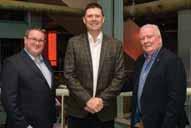





According to the EHPA, the impact of proposed new F-Gas legislation on heat pumps clashes with the EU’s decarbonisation and energy security ambitions. “MEPs should not slam down both the accelerator and the brake pedals at once,” says EHPA’s Thomas Nowak.
2


5 6 56


Publisher and Editor: Pat Lehane
Design and Production Editor: John Gibney
Advertisement Director: Joe Warren
EFCA Manifesto for 2030+
5 8 58

News and products 2 Towards NetZero awards 14 Wilo: swap old for new 16 Underfloor heating tests 18 Unipipe dry-fit UFH 21 Sustainable Grant 24 HitachiSamurai M 26 Digital skills 30 GCP+EuropeOn assembly 34 Anatomy of lighting 36 Mitsubishi Electric App 39 Xylem at ISH 40 Hannover MESSE preview 44 Aquarea K&L award 46 Heat pump training 47 Glow-worm Compact 48 S&P Ecowatt 49 Curran retrospective 50 Anaerobic digestion 52 ATC wins at Spurs 55 ISOPARTNER launch 56 Exi-tite built on trust 57 BTU gold 58 Design + Construct 60 Lindab expansion 61 SEAI energy webinars 62 REHVA update 63 Obtuse Angle 64 Building Services Engineering l March/April 2023 1 Contents Published by: Pressline Ltd, Carraig Court, George’s Avenue, Blackrock, Co Dublin. Tel: 01 - 288 5001/2/3 email: pat@pressline.ie www.buildingservicesengineering.ie
Pressline Ltd. Printed by:
ISSN 2712-0198 Vol. 62 No. 1 © All contents copyright Pressline Ltd. EDITORIAL
Design:
W&G Baird
A recently-produced position paper by Europump explains how the European pump industry interprets the requirements of the Circular Economy Action Plan and how the associated initiatives will dovetail into its future work and activities.
4 4 44
3 4 34
8 41
ENGINEERS MUST BE CONSULTED
Looking to help deliver a resilient, green and digital built environment, EFCA’s recent manifesto calls for joined-up policy making, developed not in silos, but in collaboration at inter-institutional level and with the full participation of the engineering sector. 8 28
IWBI executives visit Dublin

Stephen Brown and Giovanna Jagger from the Global Market Development team at IWBI visited Dublin in January to connect with the local WELL Community and clients. Together with Mona Duff, IWBI’s local representative in Dublin, the team hosted a WELL Summit, presenting the latest updates around WELL and key motivations that are driving the explosive demand for WELL.
Following the summit, IWBI hosted a WELL community event in Café en Seine in Dublin that gave local WELL consultants and clients the opportunity to connect and socialise.
CIF Health & Safety conference
The CIF Health & Safety Summit will take place on Thursday, 25 May 2023, at Croke Park, Dublin. The early bird booking rate of €175 +vat for CIF members, and €225 +vat for non-members, is now open.
The summit will feature some of the most established thought leaders on safety who will share their insights on how organisations can authentically embed health and safety, mental health and wellbeing into its fabric.
Rowan CPD-accredited
Rowan Engineering Consultants has recently been awarded the CPD Accredited Employer Standard by Engineers Ireland in recognition of its continuing professional development.

With offices in Trim, Co Meath, Oranmore, Co Galway and the Guinness Enterprise Centre in Dublin, Rowan’s engineers and scientists provide a wide range of expertise to clients throughout Ireland and Europe.
Commenting on the importance of the CPD Accredited Employer Standard, Stephen Flood, Forensic Director at Rowan, added: “We know that investment in our team’s continued professional development is essential to attracting, retaining, and developing people, and in maintaining our competitive edge.”
LAI DIALux evo training course
DIALux evo is the world’s leading lighting design software. More than 750,000 professional users worldwide – including engineers, electricians and lighting designers – plan, calculate and visualise light for indoor and outdoor areas using DIALux evo.
DIAlux evo training is essential for the worldwide standard in lighting design software and the forthcoming Lighting Association Ireland (LAI) course is open to anyone involved in designing indoor and outdoor lighting, emergency lighting, road lighting and realistic visualisation.
The course presenter is Iain Macrae, CEng, FSLL, MCIBSE (pictured). Iain is a renowned lighting specialist with over 30 years experience in lighting design, consultancy and training. The course is spread over two days and covers two modules – Foundation Level and Intermediate Level.

Who is it for? – lighting designers; technical personnel; sales personnel; product designers; lighting engineers; electrical designers.
For full details on the course visit www.lightingassociation.ie
IRI conference
The theme for the IRI National Conference 2023 is E-Heat: Decarbonisation and Net Zero, the role of Heat Pumps and Refrigeration Heat Recovery. It will take place on Wednesday, 19 April 2023, at the Green Isle Hotel in Dublin..
The event is aimed at:
• Refrigeration, air-conditioning and heat pump contractors and installers;
• Refrigeration and heating system designers and consultants;
• Industrial and commercial facility owners and managers;
• Architects and structural engineers;
• Energy managers, environmental and sustainability personnel.
2 Building Services Engineering l March/April 2023
NEWS AND PRODUCTS
Pictured are: Damien Owens, Director General of Engineers Ireland with Stephen Flood, Forensic Director and Tom Rowan, Managing Director of Rowan.
Giovanna Jagger, IWBI Senior Director with Stephen Brown, Senior Vice-President and Mona Duff, Senior Manager.
GREEN SOLUTIONS, FOR A BETTER CLIMATE.








Your ideal partner for the future of pump technology Wilo have what it takes as a manufacturer who can truly understand the many applications of our products in real-world situations. Staying abreast of Global Megatrends enables us to develop products which are ready for the challenges of tomorrow. Digitalisation to cope with the demands of globalisation and urbanisation.

Your ideal partner for the future of pump technology - Wilo have what it takes as a manufacturer who can truly understand the many applications of our products in real-world situations. Staying abreast of Global Megatrends enables us to develop products which are ready for the challenges of tomorrow. Digitalisation to cope with the demands of globalisation and urbanisation.

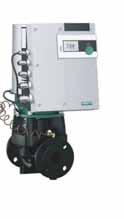



For further information please contact our sales team

Pioneering for You
Glandless Circulators Wilo-Stratos MAXO
Glanded Circulators Wilo-Stratos GIGA
Boosters Wilo-SiBoost Helix EXCEL
T: +353 (0)1 426 0000 |E: sales.ie@wilo.com | www.wilo.com/ie/en | @wilo_ie | @wilo_ie | @WiloIreland
Drainage & Sewage EMUport CORE
Pioneering for You Pioneering for You
Digital Construction Week
Hosted across two days on 17 and 18 May 2023 at ExCeL London, Digital Construction Week (DCW) offers insight and inspiration to help built environment professionals design, build and operate better.

Visitors will meet over 150 established brands and cutting-edge start-ups showcasing the latest tech, tools and solutions for digital construction. They will also hear from the industry’s brightest minds and get up to speed with key trends in the free-to-attend education programme featuring 300+ expert speakers.
There will be nine theatres focused on some of the key areas shaping digital construction. These include information management, asset management, geospatial, visualisation, digital transformation, Net Zero and more.
To register see https://www.digitalconstructionweek.com/
Intel continues partnership with EI
Intel is to continue its partnership with Engineers Ireland’s STEPS programme with the aim of encouraging and inspiring the next generation of STEM talent.

Commenting on the partnership, Joe English, Intel Ireland Fab34 Factory Manager, said: “We believe that young people are vital to solving global challenges. A solid maths and science foundation, coupled with skills such as critical thinking, collaboration and problem solving, are crucial skills to be nurtured and developed.
“We are pleased to continue our partnership with the Engineers Ireland STEPS programme and look forward to working with EI to help encourage all young people to embrace STEM subjects and to pursue pathways that can lead to engineering.”
See: https://www.engineersireland.ie/Schools
Lack of female role models revealed
New research from Chadwicks Group reveals that a lack of female representation and role models in construction is the key barrier to entry for young women in Ireland. The research examined the attitudes of 350 women, aged 18-24, towards a career in construction. The results revealed that 44% feel there is a lack of female representation in the industry and a resounding 93% believe more should be done to promote the industry to women.
As well as the issue of representation, the survey found that 10% say there is a lack of understanding around the types of careers open to women in the sector, while 9% said they felt pressure by their teachers or parents to pursue third level education over an apprenticeship.
Just on 88% say that more should be done to promote apprenticeships and trade-based careers at school and 60% would consider a career in construction if they knew more about it.
While barriers to entry were acknowledged, 45% say they had considered a career in the industry with architecture (26%), engineering (16%) and project management (11%) the top three choices.
Indicating that more needs to be done to promote apprenticeships and trades to women, only 5% of those polled say they have considered becoming a carpenter or electrician, while only 3% have thought about becoming a plumber.
Commenting on the findings Patrick Atkinson (above), CEO, Chadwicks Group said: “We are currently facing a drastic shortage of tradespeople in Ireland and more needs to be done to showcase the opportunities and benefits of a career in the trades, particularly to women. At Chadwicks Group we are committed to proactively challenging ourselves to achieve this and have a number of initiatives in place to drive higher female representation.”

NEWS AND PRODUCTS 4 Building Services Engineering l March/April 2023
Gearóid Mac Riabhaigh and Órlaith Nic Eochagáin, students from Gaelscoil Uí Fhiaich, Maynooth, Co Kildare with (back row, l-r) Damien Owens, Director General of Engineers Ireland, Anne Marie Doyle, Intel Ireland Lithography Department Manager, Joe Bolger, Intel Ireland Fab34 Factory Manager and Joe English, Intel Ireland Fab34 Factory Manager.
CIBSE CPD training modules

CIBSE has compiled a list of training courses focusing on regulations, legislation, standards and codes of practice which can be purchased for six or more employees, face-to-face or online. They are:
• Energy Efficiency Related Building Regulations: Part L;
• Fire Safety Building Regulations: Part B;
• Introduction to the Building Safety Act;
• Embodied Carbon in MEP Design: How to use CIBSE TM65;
• Emergency Lighting to Comply with Fire Safety Requirements;


• Heat Networks Code of Practice (CP1);
• Overview of IET Wiring Regulations (18th edition).
Contact: Chris Valdes at cvaldes@cibse.org

New solid fuel trade body
Solid Fuel Merchants Ireland (SFMI) is a new trade body established to represent the interests of all Irish-based solid fuel retailers. Established by Colin Ahern (pictured), Marble City Fuels in Kilkenny, SFMI aims to act as a proactive partner to Government and relevant stakeholders to inform and guide on best practice in the industry.
SFMI advocates for a proportional policy and legislative approach which recognises the necessity of solid fuels as a source of energy. Its objectives are to provide representation for the industry with all high-level stakeholders during a time of profound change for the sector. The association will provide cutting-edge insights, advocacy, policy development and advice to all businesses involved in the selling or promotion of solid fuel.
Membership already comprises 50 businesses which are based right across Ireland.
Liquid gas support grant
Liquid Gas Ireland (LGI) has welcomed the new support grant for businesses that use liquid gas (LPG) as part of the Government’s cost-of-living package.
The Temporary Business Energy Support Scheme (TBESS) was introduced in 2022 to support qualifying businesses with increases in their electricity and fuel costs over the winter months. However, the scheme excluded unmetered fuels such LPG used by many businesses located off the national gas grid.
LGI Policy Director, Philip Hannon said: “Large swaths of businesses are off the natural gas grid, particularly those in the hospitality and tourism sector. They rely on fuels such as LPG and BioLPG and have been unable to access any support for their spiralling energy costs. This new support grant is most welcome.”
Contact: www.lgi.ie
HIGH PRESSURE HUMIDIFIERS
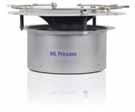

Condair high pressure humidifiers offer direct room humidification with a flexible range of options. A pump station can be combined with different nozzle systems to meet the installation needs of any project.
Contact us for free expert advice
Tel: +353 (0)91 507120
Email: ie.sales@condair.com
Web: www.condair.ie
Humidification, Dehumidification and Evaporative Cooling
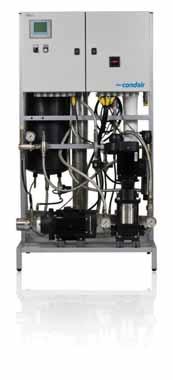
Building Services Engineering l March/April 2023 5 NEWS
AND PRODUCTS
+ FREE on-site surveys
Optimistic view from Mace
Mace, the international consultancy and construction company, has identified opportunities in sustainability and infrastructure investment for the Irish construction sector in its recently-published Ireland Market View report.
The report outlines some of the expected ongoing challenges for Irish construction for the year ahead, including prolonged high inflation and elevated costs for gas, electricity and materials. It also highlights the risk of slowed project delivery due to skills shortages.
That said, the report also identifies opportunities for the sector, with the need to improve building efficiency through retrofitting expected to provide a boost to the sector over the next 12 months. The ongoing demand for maintaining and further developing infrastructure is also a positive factor.
Andy Beard, Global Head of Cost and Commercial Management for Consult, Mace (pictured), said: “Despite ongoing challenges for the sector, there is plenty to be positive about for the construction industry in Ireland. The Irish Government has ambitious plans, particularly around energy, utilities and transport. Such investment is vital in order to reach carbon neutral targets.
“However, to successfully complete all of these schemes, the Government will require an intelligent approach to skills shortages.”
Big Carrier lift at Dundrum
As part of the fitting out of their new location in the Dundrum Town Centre, Pennys turned to Core Air Conditioning Ireland for their heating and cooling requirements. Access for plant delivery was extremely challenging and, over a number of recent weekends, Core safely negotiated all obstacles to deliver four Novair heat recovery AHUs; two Carrier packaged heat recovery heat pumps; a Carrier air cooled chiller and a Carrier air cooled heat pump.

The project is part of the ongoing Primark/Pennys expansion programme on which Core works closely with Lynskey Engineering. Kavanagh Crane Hire provided the crane (500 tonne) and Lynskey Engineering offloaded and positioned the equipment on to the roof.

C&F appointment
C&F Quadrant has appointed Peter O’Brien as Sales Director. An experienced industry professional, Peter will work closely with industry stakeholders in promoting C&F Quadrant’s brand portfolio and will realign and grow its products for changing industry standards.


Offshore policy risks 2030 targets
Wind Energy Ireland has warned that the Government’s new offshore wind policy will undermine efforts to achieve the targets set for offshore wind energy in the Climate Action Plan.
The policy statement sets out plans to deliver the second group of projects needed to reach the 5GW target, as well as proposals for the long-term development of offshore wind post 2030.
The plan proposes introducing a requirement that all future offshore wind farms must be built in designated marine areas which have yet to be identified and may not be for 18-24 months, and also that future offshore wind farms will not connect to points on land but to offshore substations to be designed and built by EirGrid, something never done by the company before.
6 Building Services Engineering l March/April 2023 NEWS
AND PRODUCTS
NEWS AND PRODUCTS
Liberties wall light
Borrowing from the distillers and brewers who were at the heart of the Liberties for hundreds of years, the focal point of this new wall light from Copperfish is a cylindrical bulb with meandering filament which appears to hover in a copper vessel..
Attached to the wall with aged brass plates, the bulb mirrors against the polished copper housing, creating an interplay of light and reflection. Blurring the lines between art and function, it is an ideal decorative piece for the home.
Its amber glass tint and low lumen provides a glare-free warm tone and creates a gentle luminescence in any space. Bulb is 75cms while the full light stands at 100cms high.

See www.copperfish.ie
CPD accreditation awarded to Uisce Éireann
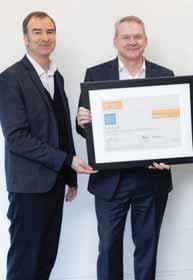
Uisce Éireann has been awarded the CPD Accredited Employer Standard by Engineers Ireland in recognition of its continuing professional development (CPD) strategy. It is responsible for the operation and maintenance of the national water and wastewater assets and currently employs over 1,200 members of staff across Ireland. It supplies drinking water to 80% of the public, delivered through over 64,000 km of water pipelines.
The company also collects wastewater from over 26,000 km of wastewater pipelines and treats some 1,200 million litres of wastewater daily.
Picture shows Aidan O’Flaherty, Associate Director of CPD at Engineers Ireland with Niall Gleeson, CEO of Uisce Éirean.
Acquisition Opportunity Long Established Company in Air Conditioning Sector
The Opportunity
The company is long-established in the supply, maintenance and repair of Air Conditioning and Refrigeration systems. The company operates primarily in the East and South East of Ireland with its primary sectors being in the Food and Pharma Sectors with a number of blue-chip and multinational clients.
Key Aspects
• Stable turnover over the past three years;
• Has developed strong strategic relationships with customers and suppliers, built over many years of successful operation;
• Customer-focused solutions at the core of the company’s business strategy;
• Equipped and geared to supply both standard and bespoke products;
• Owners’ retirement;
• Premises on a freehold or leasehold basis;
• Sourcing experience and depth of market knowledge and understanding.
Key Opportunities
• Opportunity to grow turnover due to increasing market demand;
• Opportunity to grow through additional distribution alliances;
• Opportunity to grow through diversification into other products and market segments.
Key Performance Indicators
• Turnover: €500,000 - €600,000;
• GP Margin: 50% +;
• Adjusted EBITDA Margin: 25%+.
Transaction
• Offers are being sought for the entire issued share capital of a newly incorporated company into which the trading assets of the business will be transferred;
• A full IM together with details of the sales process can be made available upon receipt of a signed NDA.
Please contact:
Maurice Kirwan, Partner, MK Brazil.
T: 353 51 840800.
E: mauricekirwan@mkbrazil.com
Building Services Engineering l March/April 2023 7
Delivering a resilient, green and digital built environment EFCA MANIFESTO FOR 2030 AND BEYOND


The European Federation of Engineering Consultancy Associations’ (EFCA) mission is to promote the European engineering consultancy industry at EU level and to represent it in the policy-making process of the European institutions. As experts in the field, EFCA contributes to the development of EU legislation that affects the industry, working collaboratively to achieve common European goals. These include the Green Deal and climate objectives, digitalisation and innovation, promotion of fair competition, transparent procurement rules and the training and support of young professionals.
Looking to help deliver a resilient, green and digital built environment, EFCA has just published its manifesto for 2030 and beyond. It calls for joined-up policy making, developed not in silos, but in collaboration at inter-institutional level and with the full participation of the engineering sector. This process should take into account the competence of consulting engineers in terms of planning, technical design, management, operation and maintenance, while regulatory measures should remain technology- and materialneutral.

Collaboration is ever more important with the economic backdrop that has emerged in recent months, during which
we have seen soaring inflation and energy prices. These conditions are exacerbating the concerns of already risk-averse clients and insurers, adding to the burden on consulting engineers who continue to face more demanding contracts. While firms in the sector fully acknowledge their responsibility and accountability for the highest possible quality of their work, the risk of litigation increases their own risk and reduces already-small margins. In short, the challenges for consulting engineers are greater than ever before. Nonetheless, EFCA and its member associations (and their member companies) pledge to invest time, energy and expertise focusing on the future and a betterbuilt environment.
It commits to proactive solutionseeking, engagement in policy development and professional and constructive dialogue with policy makers. The recently-published manifesto focusses on six critical areas with specific policy recommendations designed to deliver on this commitment.
• continued page 10
8 Building Services Engineering l March/April 2023
European Engineering Consultancies
Build warmth with Grant

Our complete integrated heating packages provide everything needed to build a highly efficient, warm and comfortable home.
Tailored to suit the homeowners’requirements, each Grant heating package is correctly sized and specified, free of charge, to achieve compliance, maximise efficiencies and provide long-term savings.

Packages feature the Grant Aerona3 air to water, air source heat pump, Grant hot water cylinders, Grant Afinia aluminium radiators and the Grant Uflex underfloor heating system. Smart controls are also available.


Trust Grant on the journey to warmth and comfort by sending house plans to heatpump@grantengineering.ie

 Sue Arundale, Director General EFCA.
Sue Arundale, Director General EFCA.

EFCA MANIFESTO FOR 2030 AND BEYOND



1 Responding to the climate emergency

• Ensure that all future legislative proposals aimed at the built environment be impact-assessed for climate vulnerability and resilience. From this point on, public procurement, climate and energy policy, buildings, infrastructure and products, industrial equipment and processes – in fact every policy development that has a bearing on our physical assets – needs to pass this test.
• Make the new European Bauhaus an incubator for research activities aimed at developing climate solutions and give consulting engineers the same profile as architects in this important initiative. Engineers and architects are key partners and, in fact, many consulting engineers are also architects. Where this is not the case, both professions can learn from each other and the Bauhaus can provide the perfect co-creation space, encouraging a meeting of minds between both professions.
• Acknowledge EFCA as one of the leading industry partners in the Construction 2050 Alliance.



2 Completing the digital transformation


• Implement the findings of the DigiPLACE project which, with partners from across the value chain, developed a Reference Architecture Framework for an EU digital platform for the construction industry. Ensure its inclusion in relevant policy.

• Demand mandatory adoption of open standards by public clients in procurement and eliminate prescriptive use of proprietary software and file formats. Ensure that regulation aimed at promoting data-sharing, such as the Data Act, guarantees fair treatment and protection of intellectual property.
• Close loopholes to make it impossible for third parties, including information and communications technology providers, to misuse data from technical design solutions for commercial gain.
3 Ensuring success of sustainable development projects
• Increase EU technical assistance funds at country level and get the support of consulting engineers in the preparation of projects through service contracts. European Union delegations should coordinate the funding and the project pipelines to ensure that they are relevant and policy-aligned.
• Provide for the inclusion of data collection, analysis and integration of sustainability-related data in the planning and design phases, in addition to data monitoring during the implementation phase, as part of EU-funded consultancy services.
• Streamline and standardise all procurement and contracting procedures in “Team Europe” development financing institutions in order to facilitate the proper participation of companies, particularly SMEs, in tenders and contracts.
10 Building Services Engineering l March/April 2023
4 Achieving highest quality result in procurement
• Improve and increase the use of green procurement by ensuring that publicsector officials responsible for procurement have the relevant knowledge of not only green procurement policy, but of its benefits when applied.
• Encourage public clients to award contracts to bidders that have adopted the collaborative contracting approach.
• Adopt a minimum price/quality ratio of 30/70 in award criteria and aim for a 20/80 proportion.

5 Making engineering the career of choice
• Ensure that initiatives, such as the EU Pact for Skills, boost education and training programmes that allow technicians
to become engineers during the course of their careers and encourage female students to choose engineering.
• Bring the new European Bauhaus into schools and vice-versa. Involve children, via workshops, play and curricula, to trigger aspirations and dreams to become an engineer.
• Ensure that the European Year of Skills in 2023 addresses the skills shortage in the construction ecosystem.
6 Pioneering solutions for future generations



• Innovative solutions and emerging technologies must be systematically allowed as “variants” in public procurement.
• Ensure that the Horizon Europe programme and the new European Bauhaus stimulate collaborative innovation, eliminate research in silos and ensure that the results of research, as well as innovative solutions developed outside

of funding programmes, are rolled out for wider use.
• Facilitate collaboration with experts from other industries to allow the sharing of best practice and learning via European Commission-supported platforms and workshops. This will help accelerate the transformation of the industry, while avoiding costly solution development that duplicates those that have already been found in other sectors.

About EFCA



The European Federation of Engineering Consultancy Associations (EFCA) is the only federation to represent the engineering consultancy industry in Europe.
Founded in 1992, EFCA has member associations in 28 European countries representing over 10,000 companies and more than one million staff in engineering and related services.
As experts in the field, EFCA works to influence EU legislation on matters that affect the engineering industry, helping to achieve common European goals such as the promotion of fair competition and transparent procurement rules.

“ Building Services Engineering l March/April 2023 11
efca@efca.be
EFCA and its member associations pledge to invest time, energy and expertise focusing on the future and a better-built environment.
E:
www.efcanet.org

Towards NetZero Awards 2023 Declare your intent to enter
The appetite and enthusiasm for the Towards NetZero Awards were very much in evidence late last year where approximately 100 industry leaders and net zero champions gathered to celebrate the achievements of the various awards winners for the inaugural event. In doing so they also set the benchmark for the 2023 awards which include additional categories to accommodate the more diverse submissions now anticipated.
Achieving net zero buildings is a daunting objective but one in which architects, consulting engineers, mechanical and electrical contractors and building contractors are already showing admirable leadership. The Towards NetZero Awards are designed to recognise their achievements to date, and to encourage others in their efforts to do likewise.
Submissions are open to all construction disciplines and professions, while clients can also make a submission in conjunction with their building design team. A distinguished and experienced panel of judges will assess all entries submitted via the online process with shortlisted finalists being invited to a gala presentation ceremony.
To facilitate the expected increase in entries for 2023 – and the additional number of awards’ recipients – the presentation ceremony will now take place on Friday, 10 November 2023, in the prestigious venue of the Concert Hall in the RDS.

Awards categories
Commercial Building
This category recognises projects that provide high-quality workplace environments while pursuing net zero strategies that ensure a reduction in energy use and carbon emissions, thereby impacting the effects of our everyday work practices.
Public Building
This category recognises projects commissioned by public or semi-public bodies and agencies that demonstrate a civic function and are accessible to all. Such buildings should illustrate an overlapping interest in the provision of public-facing functions alongside ambitious sustainability objectives.
Housing Development
This category recognises multi-unit residential projects that aim to reimagine the sustainable credentials of the typical Irish suburban housing estate – a type of development often associated with promoting carbon-intensive lifestyles but which also holds a significant capacity for change and innovation.
Design Practice
This category recognises the design team that pushes the principles of sustainable design throughout their work, whether in pursuing new research, exploring contemporary innovations, or leading in best practice.
Retrofit of a Building
This category recognises projects which bring under-utilised existing building stock back into contemporary use, achieving a more sustainable built environment through the re-use of extant properties and significantly improving their energy performance.
Net-Zero Champion
This category recognises an individual member of a design or contracting team who has demonstrated exceptional commitment and understanding in the application of net zero strategies, either with regard to a particular project or across their work as a whole.
NetZero Home
This category recognises the role one-off homes can play in meeting net zero targets and in ensuring that the country’s collective carbon footprint is reduced – ranging from site utilisation through to design concept, sustainability, materials used, the principles of circularity, etc.
Apartment Development
This category recognises urban dwelling schemes that seek to maximise the energy efficiencies to be gained in dense, residential development, while taking advantage of the opportunities afforded by communal buildings in terms of both design and operation.
Engineering Project
This category recognises projects which adopt net zero strategies at the infrastructural scale, utilising both technical knowledge and innovating thinking in the design of those structures which underpin and serve the wider built environment. See www.netzeroawards.ie for further details and to declare your intention to make a submission.
14 Building Services Engineering l March/April 2023
Left: The inaugural NetZero Awards’ winners pictured in the RDS during the presentation ceremony last year.
Visit our Customer Learning Centre!

The ATC Academy is your hub for strengthening your knowledge of the ATC range of energy efficient heaters and hand dryers through core product training.

Who is it Designed For?
• Electrical Wholesaler Sales Personnel
• Architects
• Electrical Contractors
• Consulting Engineers
Earn CPD Points
Engage in CIBSE-approved CPD training by undertaking ATC’s Electric Heating Technology course. Training can be delivered at ATC House, or on-site at your business premises.



Book your Visit | sales@atc.ie | 01 467 8301
“Thank you ATC for the warm welcome and professional presentations – it was certainly one of the best that we have received from one of our suppliers.”
High-efficiency models key to sustainability
Wilo urges installers to swap old for new
With cold snaps causing breakdowns in old heating systems, Wilo has called on installers to take the opportunity to fit modern, efficient pumps to help homeowners save as much as 80% in energy and reduce their running costs.

Recent months have seen a significant drop in temperatures with peoples’ heating systems and pumps breaking down as a result of these dropping temperatures. The problem is more prominent in larger, older properties. It also impacts systems that have not been turned on for long periods of time, allowing sludge and debris to build up in pipes and components.
Wilo is now encouraging installers who are fixing or upgrading heating systems to avoid “like-for-like” fixedspeed pumps, and instead seek high-efficiency models to help their customers save energy this year and beyond.
For example, based on an approximate cost of 39 cent per KwH for electricity, and the heating being on 24 hours a day, an old, fixed-speed 100W pump could cost 98 cent to run. In comparison, a modern pump with an electronically commutated (EC) motor works from as low as 4W to a maximum of 40W,
meaning a 60% reduction in electricity usage, and bringing running costs down significantly to approximately 38 cent per day. If the pump operates at a lower speed, these costs can be reduced even further, by as much as 80%.
Derek Elton, Managing Director, Wilo Ireland, said: “Many homeowners, especially those who live in older or larger houses, often find that their heating systems break down at extremely inconvenient times, such as the height of a cold snap.
“While this is an inconvenience, it is also a chance for installers to help homeowners upgrade their systems. There are many high-efficiency heating circulator pumps available on the market now, like those from our Yonos PICO range. These typically offer up to 80% better performance in terms of energy efficiency owing to EC motor technology. They also incorporate many smart features like working only on demand to save homeowners money.”
Along with helping homeowners in the cost-of-living crisis, it also helps them be more sustainable with energy usage. Choosing modern pumps can also help installers save time in both fitting, commissioning and maintenance.
“One of the big challenges that the plumbing and heating industry faces is that there just aren’t enough installers,” says Derek. “We know there is a skills gap and installers are some of the most time-poor trade professionals. Additionally, attending a call-out can also be unpredictable, as fitters won’t know what they’re facing in airing cupboards until they get to site.
“That’s why the choice of materials can really matter. Products like our Yonos PICO range have been designed with a small footprint to fit into tight spaces, with tool-free wiring for simple and faster connection. The range also houses innovative features like pictograms to make the commissioning stage much simpler and quicker. We also have plenty of stock across our entire portfolio so there is ready availability from all merchant stockists.”
16 Building Services Engineering l March/April 2023
Left: Replacing fixed-speed pumps with high-efficiency models saves energy, time and money.
LG AIR SOLUTIONS’ LARGEST DISTRIBUTOR IN IRELAND AND THE UK








HVAC SUPPLIER DESIGN SUPPLY SUPPORT GROUP
C www.exi-tite.com AIR CONDITIONING | VENTILATION | DX | AWHP Save time on your project with the LG DESIGN SUITE LATS HVAC | LATS CAD | LATS REVIT
know LG. Find out about the latest LG VRF system, with AI engine by getting in touch with us.
salesirl@exi-tite.com
As LG Air Solutions’ largest distributor in Ireland and across the UK, Exi-tite provides comprehensive design collaborate extensively with our partners to ensure we have the right in-house knowledge and our unrivalled experience of LG equipment means your projects will run smoothly and be completed on time.
We
[E]
* Multi V i
Tests prove efficiency of lower flow temperatures

BEAMA’s Underfloor Heating Group has released the latest results from its collaboration on the BEIS DEEP project at Salford University Energy House, providing further evidence that lower flow temperatures can support heat sources to operate more efficiently.
The tests are conducted on response times of various underfloor systems with the key aim of providing BRE and SAP with figures reflecting current installation practices.
The Energy House, sited in Salford University, allows for laboratory-level monitoring of the system and room temperatures over current SAP standard time profiles. The data is derived from tests of three typical underfloor heating construction types in line with BS EN 1264.
The data analysed so far has shown that response times of all floor constructions significantly improved on the current SAP assumptions for underfloor heating systems – coupled with the figures to prove that lower flow temperatures also result in the more efficient operation of the heat source.
Kevin Ray, Portfolio Manager for the BEAMA Underfloor Heating Group comments: “As a group, we are constantly looking at ways to provide the latest, data-driven information and updates on underfloor heating

and how it can support the industry to progress to a zerocarbon future collectively.
“These latest test results prove why low-temperature underfloor heating is the primary technology for heating systems. As the analysis of this latest data continues to be analysed, we look forward to sharing more information and updates.”
For further information about BEAMA, visit https://www.beama. org.uk/portfolios/underfloorheating1.html
18 Building Services Engineering l March/April 2023
UNDERFLOOR HEATING
Kevin Ray, Portfolio Manager for the BEAMA Underfloor Heating Group.


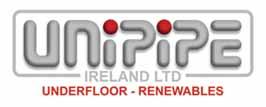
REGISTERED TRAINING PROVIDER 2023
Energy House ‘realtime’ laboratory
Sited in Salford University, Manchester, the Energy House is a unique research and testing laboratory that comprises an early 20th century two-bedroom terraced house within an environmental chamber allowing an accurate and rapid assessment of energy-efficient retrofit technologies.

It is a traditional construction – solid brick walls, suspended timber floors and single-glazed windows with a conventional “wet” heating system fired by a gas boiler. The environmental chamber can be used to simulate a wide variety of weather conditions with a temperature range from -12°C to +30°C. The chamber is also equipped with rigs to simulate wind, rain, snow and incident solar radiation.
Throughout the chamber and the house there are over 200 monitoring points with real-time data collection of parameters such as temperature,
humidity, heat flux, electricity and gas consumption.
The facility underpins a range of research topics including:
• Building physics/performance;
• Sensors/data collection;
• Data analysis and visualisation;
• Human factors;
• Smart meters and connected homes. Energy House explores issues of energy consumption in buildings. It uses data from large-scale field trials and building performance tests to construct accurate models and simulations of buildings and data analytics to look at large data sets of building and energy performance. The research team works with partners across a range of commercial and grant-funded projects, providing a comprehensive offer of energy and buildings expertise.
BEAMA Specifier & Installer Guides
The BEAMA underfloor heating group also produces various guides primarily aimed at installers and specifiers to provide valuable resources that include information on compliance with regulations, control technologies, and evidence on the energy savings from controls. Among these are the following:
•The guide to low-profile and responsive underfloor heating;
•Choosing the floor covering to maximise the underfloor heating efficiency;
•Guide to underfloor heating controls for domestic properties;
•Guide to types of underfloor heating pipework.
20 Building Services Engineering l March/April 2023
UNDERFLOOR
HEATING
Above: The Energy House research and testing laboratory at Salford University, Manchester.
Innovative dry-fit UFH system from Unipipe

The unique Ideal Classic NEO 20 underfloor heating system from Unipipe is designed to be installed without the use of wet screed and, at just 20mm high, is ideal for use upstairs in timber floors and in homes with engineered joists. The underfloor heating pipework is fitted into shallow pre-engineered EPS boards, with an aluminium coating that helps to transfer heat optimally into the floor finish above.
The Ideal Classic NEO 20 system is an adaptation of the established Ideal Classic EPS 30 devised by renowned German manufacturer MFH. The advantage of the latest version is that the installation height is reduced by 10mm, while a 16mm heating pipe is still used, meaning that the heat output and pressure loss remain identical.
The system elements are laid according to the usual, simple principle of the MFH Ideal system. The 0.5mm thick aluminium
heat-conducting sheets are already attached to the NEOPOR and the pipe channels have an omega shape to optimally fix the 16mm pipe. Floor coverings can be laid (almost) directly on the heating elements.
Ideal Classic NEO 20 can be combined with all common screeds and is particularly suitable for drywall construction. In combination with innovative heat-conducting layers, a high level of heat output is achieved and rapid heating up and down is possible, making it particularly energy-efficient.
“These underfloor heating systems are ideal for new-build or retrofit,” says Paul O’Donnell, Managing Director, Unipipe, “and challenge the misconception that underfloor heating is too awkward and difficult to install on the first floor and above. Apart from the comfort and performance levels, it also offers a solution for those who don’t want radiators cluttering up wall space.
“We also supply a strong, 5mm board made from recycled materials which, when placed over the MFH 20mm boards, can then take the laying of ceramic tiles. This solution is ideal for apartments and also offers the added benefit of soundproofing the floors.”

Features and benefits
• Easy-to-install with a low installation height;
• An installation height of 40mm, including flooring, is possible with CompactFloor;


• The 16mm pipe can also be used at a low height;



• Technically compatible with the Ideal Classic EPS 30;
• Flexibility and efficiency in one system.
Contact: Unipipe Ireland Ltd.
T: 01 – 286 4888;
E: info@unipipe.ie; www.unipipe.ie
Building Services Engineering l March/April 2023 21
Ideal Classic 20 is ready for tiles or other floorcovering when the 5mm board is placed over the MFH 20mm boards.

Polytherm Heating Systems Ltd Muirfield Drive, Naas Road, Dublin 12. T: +353 1 419 1990 Furry Park Industrial Estate, Santry, Dublin 9. T +353 1 842 703 South Ring West Business Park, Tramore Road, Cork. T +353 21 432 1066 E sales@polytherm.ie WARM, COMFORTABLE, EFFICIENT IRELAND’S LEADING UNDERFLOOR HEATING SPECIALISTS WWW.POLYTHERM.IE
AT THE FOREFRONT OF INNOVATIVE DESIGN
Polytherm Heating Systems was formed in 1999 from the success of the underfloor heating division of its parent company, Hevac Ltd. Since then, Polytherm has continued to be at the forefront of underfloor heating design and innovation. For Polytherm staff, customer satisfaction is the primary goal. When the company receives plans from a homeowner, an installer, mechanical contractor, merchant, consultant engineer or architect, Polytherm’s design engineers and CAD technicians respond with an initial design and open a dialogue to determine what will best suit the project at hand.
Once the team knows these requirements, it produces mechanical and electrical drawings to match the final design. If
Key Factors for underfloor heating design

Polytherm’s Multilayer pipe is specifically manufactured for underfloor heating applications;
Polytherm’s engineers will select the correct manifold set-up for your heat source;

Polytherm’s engineers will design a solution based on the thermal resistance of the floor covering;
Polytherm’s underfloor heating takes advantage of radiated heat transfer so that lower, more comfortable room temperatures are utilized;
Polytherm’s underfloor heating system components are backed by the company’s guarantee, working together for ease of operation.
assistance is required prior to installation, a site visit can be easily accommodated.

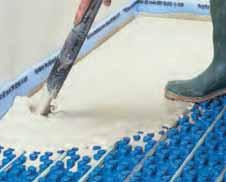
Polytherm engineers are also available over the phone, if technical support is required, or if a homeowner has any questions about their underfloor heating system. Once the system is installed, a commissioning engineer is available to call out to the project.
Energy saving
In today’s world, low energy housing is a must due to the building regulations and our commitments to reduce greenhouse gases moving toward the future. By the nature of its low running temperatures, underfloor heating is more efficient than traditional heating systems when used with a renewable heating source. Lower temperature is key to achieving high performance when used in conjunction with heat pumps and key to lower fuel bills. As a heat pump system only requires a low-flow temperature between 35°C and
45°C, Polytherm can exploit the higher efficiencies that heat pumps can achieve. Further savings can be achieved by using Polytherm controls. The company’s extensive range and knowledge of controls means that your home or place of business will always be at the temperature you desire. From dial thermostats to internetready smart controls, Polytherm has got the product for you. Its intelligent controllers learn the characteristics of your building, meaning no more cold floors in the morning, or high energy bills. In fact, using smart controls can save you up to 30% versus standard controls. For underfloor heating in retrofit buildings/ dwellings where floor-to-ceiling height may be an issue for traditional systems, Polytherm offers Heatrack – a low-profile panel system. This enables installation on joist floors and existing concrete floors, increasing the useable area within rooms by removing radiators from external walls.
ADVERTISEMENT FEATURE
Advanced heating technologies
heating solutions from Grant
Designed with the property developer, architect and homeowner in mind, Grant’s innovative heating technologies work together seamlessly. This means that those working on new-build properties can save time on the project by having the full heating system designed and specified under one roof, using the best suited products, which results in a highly-efficient, compliant heating system.
It is this technical insight and careful combination of heating technologies from Grant’s diverse product portfolio that provides a bespoke integrated heating solution. The most common main heat source featured in Grant’s integrated heating packages is the A+++ Aerona3 R32 air to water air source heat pump.
Available in four outputs of 6kW, 10kW, 13kW and 17kW, Grant’s Aerona3 R32 air to water air source heat pump offers a sustainable form of heating. The Aerona3 has quickly become a popular choice among specifiers and installers due to its cleaner, more environment-friendly performance, and its ability to lower a property’s overall carbon footprint, which will ultimately help to achieve NZEB building standards.

Units within the range have achieved an A+++ energy rating at low temperatures such as 35°C or 45°C, which continues to highlight Grant’s commitment to providing marketleading heating solutions. All four models also boast superior seasonal coefficient of performance (SCOP) and, depending on climate conditions and demand on the heating system at the time, can deliver 4kW of heat energy for every 1kW of electricity used. The
13kW and 17kW models within the range have also been recognised for their low noise qualities by the international award programme, Quiet Mark.
The Aerona3 R32 heat pump’s ability to work in tandem with other Grant heating technologies adds to its popularity. In particular, the Aerona3 works well when combined with Grant’s Uflex underfloor heating system as both technologies can run at lower temperatures, therefore providing significant carbon and financial savings for the property owner.
An ideal heating solution for new-builds, Grant’s Uflex underfloor heating system offers convenient and highly-efficient heating. This unobtrusive heat source is embedded within the floor construction and is fitted as part of the floor’s assembly process, therefore causing no delays in construction. The pipework is available in PERT and ALUPERT and is positioned and clipped into place using Grant’s tracking and staple system once the flooring’s insulation and membrane has been fitted.
After this a flow screed is laid over the top and allowed to dry before heat is introduced. As the system is designed for continuous operation with heat being supplied through the screed all day, this also means that the screed acts as a thermal store.

To avail of a fully-integrated heating system the main heat source and heat emitters must then be complemented with hot water storage, like the Grant Integrated Unit. This space-saving integrated unit was developed to work with the Grant Aerona3 R32 air to water air source heat pump range. Standing at 1.8 metres high and with a footprint of 625 x 595mm, the unit can be installed neatly within domestic spaces to ensure an optimumefficiency, complete heating solution.
The pre-plumbed and pre-wired unit also features aesthetically-pleasing white panelling and can be easily incorporated into the design of most modern homes, with the system controls and display highly accessible if required.
On receipt of house plans, Grant’s technical specialists design and specify the full heating solution for a property, free of charge.
For further information on Grant’s home heating design service email house plans, a contact number and preference of heat emitters to heatpump@grantengineering.ie.
Visit www.grant.eu for more information on Grant’s range of innovative heating solutions. Follow Grant on Facebook and Twitter @ GrantIRL or Instagram @Grant_IRL.
Think Heating. Think Grant.
24 Building Services Engineering l March/April 2023
Fully-integrated, sustainable
Grant Aerona3 R32 10kW air to water air source heat pump.
Grant’s Uflex underfloor heating system.











E: sales.ie@solerpalau.com T: 01 412 4020 www.solerpalau.ie
Hitachi’s Samurai M solves logistical challenges
and it is good for the planet
Back in Q4 2019, the World Green Building Council reported that building and construction were responsible for 39% of all global carbon emissions, with operational emissions from energy used to heat, cool and light buildings accounting for a total of 28%. The UKGBC found that 69% of operational emissions from the built environment were used in heating buildings which accounts for 10% of the total UK carbon emissions.
With this as the backdrop, it is clear the HVAC industry has a big part to play in driving down operational carbon emissions. Hitachi has been designing highly energy-efficient equipment for years, making units compact for economy of transport and modular for ease of installation. The ultra-compact R410A Samurai M chiller is no exception with a SEER of 4.5 (24HP), SCOP of 3.54 (50HP) and optional low noise level of 6 dB(A) average.
“All included” design as standard Perfect for the replacement market, Samurai M has a 2.7m2 footprint for 130kW of heating and, being “modular by design”, it is adaptable to the demands of the space. All models come fully loaded with a range of components as standard:
• Low leaving water temp kit;
• Master/slave mode;
• MODBUS/BACnet interfaces;






• Anti-corrosion protection of fins, flow and water filter;
• Onboard touch control operates up to 16 units in a cascade system.






Samurai M chillers feature two to four independent refrigerant circuits from 44kW to 254kW cooling. The automatic distribution of operation hours for the compressors increases component durability and the modular design ensures continuous operation in the event of a single unit failing. It also limits site redundancy investment.
But the key to equipment energy efficiency lies not just in the equipment itself but in how it is set up, controlled and maintained.
Controls are key
With commissioning and set-up it is important that building owners, operators or occupiers are involved in the control scheduling decisions so that equipment operations are tied to the business needs and the building’s requirement for heating, cooling and hot water delivery, accounting for the variations for seasonal conditions.
Often overlooked, controls are the key component that ensure a system’s efficiency, provide a comfortable room environment and prevent wasted energy.
Lower operating costs
For medium and large installations, a centralised control system like Hitachi’s CS-NET Manager can connect all heating, cooling and ventilation systems onto one touchscreen controller, enabling both onsite or remote control, monitoring and scheduling, and allowing changes to be made to ensure the optimal efficiency of the system.
Enabling this technology and commissioning it the right way will lead to a better deployment of engineers, lower operating costs, a reduction in the operating carbon and reduced equipment downtime.
As demand for cooling and heating continues to grow, manufacturers will continue to invest in R&D to cut carbon emissions. However, everyone can do their bit now by ensuring that systems are correctly set up and that controllers are maximising energy and labour efficiencies.
Contact: Paul McGettigan, Area Sales Manager Ireland, Hitachi Air Conditioning Europe. T: 086 107 7274; E: paul.mcgettigan@jci-hitachi.com



26 Building Services Engineering l March/April 2023
…
Paul McGettigan, Area Sales Manager Ireland, Hitachi Air Conditioning Europe.
Compact Combi …
small in stature but big on performance!
They say great things come in small packages, and that’s exactly what you get with the Compact combi boiler. It’s the most compact and lightweight boiler we’ve ever produced, but don’t let its small stature fool you – this boiler delivers big performance. It’s sturdy, reliable and is dream to install, saving time, hassle and bruised knuckles. With a stainless steel heat exchanger, it also ensures a durable long-lasting performance.
Features and benefits
• Small footprint
• Stainless steel heat exchanger
• Two outputs: 24kW, 28kW


• Lpg versions
• Combi only
• Comes as a pack – boiler+flue
• Optional time clock
Everything you need to keep glowing

Dublin +353 (1) 630 5757 • Belfast: +44 (28) 90 36 55 55 • www.cfquadrant.ie
EHPA slams MEPs vote on F-Gas phase-out

On Wednesday, 1 March 2023, the EU’s Committee on Environment, Public Health and Food Safety (ENVI) voted to fasttrack the phasedown of fluorinated greenhouse gases (F-gases) in a number of applications, including heat pumps. According to the European Heat Pump Association (EHPA), this position represents a ban on equipment containing F-gases, in some cases as early as 2026.
“MEPs should not slam down both the accelerator and the brake pedals at once,” says Thomas Nowak, Secretary General of the European Heat Pump Association. “The EU needs to decarbonise and get off fossil fuels in heating with top priority. It has recognised heat pumps as the solution – so, the road ahead needs to be cleared of obstacles, not blocked off. The industry is committed to the safe handling of refrigerants and the transition to refrigerants with a low global warming potential, with the aim of reaching zero emissions through heat pump technology by 2050.”
According to the EHPA, the impact the ENVI’s vote would have
on heat pumps clashes with the EU’s decarbonisation and energy security ambitions – as well as with the REPowerEU targets – which call for annual hydronic heat pump sales to double, with 10 million additional units to be sold by early 2027.
Extrapolating the underlying growth rate to air-to-air heat pumps, which play a significant role in decarbonising heating and cooling in the Nordics and the
Mediterranean, EHPA calculates that there will be 60 million more heating (air-to-air, hydronic) and hot water heat pumps installed in Europe by 2030, on top of the 2021 stock of 17 million units.

Support from heat pump sector
The heat pump sector has pledged to support the shift from F-gases to natural refrigerants whenever possible and has already achieved significant progress in the monobloc outdoor unit segment. The implementation of new product standards and building codes will also play a crucial role in this transition.
However, the EHPA says that the ENVI’s position on an accelerated phase-out fails to consider current manufacturing and installation capacity. It risks significantly limiting the number of heat pumps available in certain market segments, pushing consumers back to fossil fuels, with far worse consequences for health and the planet.
More granular approach
Therefore, EHPA calls for a more granular approach and timeline to allow the heat pump industry to deliver on the REPowerEU objectives. “Every heat pump is better for the climate and energy security than a gas boiler, and when every day counts on the road to decarbonisation, speeding this up must be the utmost priority,” added Jozefien Vanbecelaere, Head of EU Affairs at the European Heat Pump Association. “We urge MEPs in plenary to put climate action and energy security first by enabling more and more heat pumps to be plugged in across Europe.”
The Parliament’s vote was expected during the 29-30 March plenary session.
28 Building Services Engineering l March/April 2023
PUMPS
Thomas Nowak, Secretary General of the European Heat Pump Association.
Course Description
The aim of this course is to equip the learner with the knowledge, skill and competence to design, install and commission domestic heat pump systems in a safe and competent manner and in accordance with appropriate legislation, regulations and standards. Successful candidates will meet the training criteria to register as an installer with the Sustainable Energy Authority of Ireland (SEAI).
Course Content
Induction.
Introduction to Heat Pump Technology.
Principles of Heat Pump Operation.
Course Certification
On successful completion of this programme learners will receive a: QQI Level 6 Component Certificate in Heat Pump Systems (6N5646).
Course Duration
This is a 5 day full time course. In addition self directed learning will be an important part of this course and is required in preparation for the practical and theory exams.
Course Materials
All course materials will be supplied.
Who Should attend?
Please refer to the learner entry requirements. This course is particularly suited to Craftspersons who currently install domestic heat pumps and want to become registered installers with the SEAI.
Learner Entry Requirements
Learners must hold as a minimum the National Craft Electrician.
Aptitude: Good verbal and written command of the English language is required.
Site & System Suitability for Heat Pump Installation.

Installation of Heat Pump Systems & Controls.
Commissioning & Maintenance of Domestic Heat Pump.
Funding
You may qualify for funding under the Skills to Advance Initiative (STA). STA is a SOLAS Initiative in partnership with WWETB and supported by Government.

Courses ongoing in Wexford
2023
For further details contact 086 0787057 or email: hp@wwetb.ie
www.wwetbtraining.ie www.fetchcourses.ie Waterford Wexford Training Services
WWETB is funded by the European Union – NextGenerationEU DOMESTIC
HEAT PUMP INSTALLATION
s
The ARISE project has developed a qualification framework of sustainable energy skills leveraged by digitalisation, including building information modelling (BIM).

Qualification framework for digital skills
It can be used as a structured, but flexible, base for skill development. It utilises the methodology of developing task-based qualifications and employs the “maturity-based model of digitisation skills synchronised with sustainable energy skills” which was also developed by the ARISE project as a main foundation.
Some of the main features are:
• List of 232 tasks with subtasks, with detailed action-based descriptions for each specialism;
• Each subtask is linked to a corresponding unit of learning outcome (ULO) and relevant profession;
• It connects maturity levels to skills and learning outcomes so that organisational leaders know what employees have to learn in order to grow towards the next level of BIM and digitalisation.

In summary, this report portrays the ARISE task-based qualification framework for renewable energy skills with digitalisation as an accelerator. It will serve as a foundation for the e-learning material repository from the ARISE project.
The main objective of this report is to establish the ARISE qualification framework that serves as a BIM resource and skills recognition pathway that all stakeholders can
utilise, deliver and stimulate. Further objectives of this report are to:
• Contribute to continuous professional development (CPD) recognitions for digitisation and sustainable energy skills in the construction sector;
• Upgrade national qualifications in the AEC sector, particularly those related to the energy efficiency of buildings;
• Facilitate the future development of an e-learning materials repository;
• Contribute to industry-driven and accessible instruments for upskilling both blue and white collar professionals, increasing vocational mobility;
• Facilitate future development of skills passports and registers;
• Aim for widely-recognised and standardised digital and sustainable energy skills in the construction sector.
For more information on the report or on the ARISE Project visit: https:// www.ariseproject.eu/blog/arise-taskbased-qualification-framework/
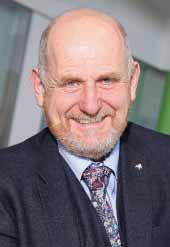
30 Building Services Engineering l March/April 2023
Paul McCormack, ARISE Programme Manager.




–
World's only 8 to 12hp
IRI National Conference 2023
E-Heat: Decarbonisation and Net Zero
The role of heat pumps and Refrigeration Heat Recovery
Latest developments, current regulations and best practice
Institute of Refrigeration Ireland
Date: Wednesday 19th April 2023
Time: 09.30 a.m. to 4.30 p.m.
Venue: Green Isle Hotel, Naas Road, Dublin
Rates: IRI Members €55 Non-Members €85

(Refreshments and Lunch provided
Bookings: info@irl.ie
Who should attend
• Refrigeration, air-conditioning and heat pump contractors and installers;
• Refrigeration and heating system designers and consultants;
• Industrial and commercial facility owners and managers;
• Architects and structural engineers;
• Energy managers, environmental and sustainability personnel.
To attend see https://lnkd.in/eDiTEC48






IRI National Conference 2023 Institute of Refrigeration Ireland
GCP Europe and EuropeOn choose Dublin for joint assembly

In an industry first, GCP Europe and EuropeOn will come together for a joint assembly in the Grand Hotel, Malahide, Co Dublin on 11 and 12, 2023. The joint activity will take place in the afternoon and on the evening of day one with both bodies having separate independent meetings over the course of the two days. As we went to press, the programme had yet to be finalised but the European Year of Skills, indoor air quality and the challenges posed by digitalisation are topics likely to be included.
Tthe Mechanical & Electrical Contractors Association (M&ECA), who are members of GCP Europe, will partner with both bodies in the event. Indeed, M&ECA Chair Eamon McGrattan, is the current President of GCP Europe. As an additional point of interest, his father, also Eamon, was among the hosts – along with Ted Bourke and Dick McElligott –when GCP Europe (then known as Genie Climatique International) had their annual convention in Dublin in the 1980s.

About GCP Europe
GCP Europe is the voice of the building services engineering sector, mechanical contractors, plumbers and HVAC installers. The association represents their interests at European Union level and, in doing so,


contributes to the achievement of the EU’s climate, energy and prosperity goals.
GCP Europe currently has 14 members across 12 European countries. The diversity of the members’ activities covers the following:
• Installing, planning and maintenance of heating, ventilation, air conditioning and plumbing systems;
• Advice on system integration and innovative smart controls;
• Regular inspections, energy auditing/ assessment (within the EPBD framework);
• Advice about energy efficiency/ performance to real estate investors and end-users;
• Advice on renewable energy systems such as solar thermal, heat pump,
biomass heating, fuel cell, power-heat coupling and photovoltaic systems;
• Performance contracting.
About EuropeOn
EuropeOn is the European voice of the electrical contracting industry. Since 1954, it has been the only forum for electrical contractors and their representatives across Europe to come together and form common positions on the issues that are important to the sector. Today, Europe is home to about 1.8 million electrical professionals, employed by 300,000 businesses and generating over €200 billion in annual turnover. Together, they are spearheading the drive for green and digital transitions across all of Europe.
Energy transition and urgency of climate action have pushed electrical contractors to the fore as electrification is increasingly recognised as the prime and most efficient pathway to decarbonise energy use.
Electrical contractors are responsible for the installation of digital infrastructure to enable digitalisation of the energy sector, especially at end-user level.
Contact: GCP Europe: Oliver Jung. E: o.jung@gcpeurope.eu; EuropeOn: Julie Beaufils. E: j.beaufils@europe-on.org; Eamon McGrattan. E: eamon.mcgrattan @cjkeng.ie
34 Building Services Engineering l March/April 2023
GCP Europe President Eamon McGrattan with GCP colleagues during a recent trip to Luxembourg.
Group pictured at the last GCP Europe gathering in Dublin in the 1980s. Included are Ted Bourke, Eamon McGrattan and Dick McElligott.
www.gcpeurope.eu
FULL RANGE, FULL BENEFITS.
YOUR PROJECT PARTNER.

APPEALING. DISTINCT. FUNCTIONAL. From shops and hotels through to industrial production halls – LEDVANCE’s expanded selection of lighting solutions offer the right solution for various environments. This is because our entire range for standard applications combines technological and design innovations with proven strengths: great value for money, simplified installation and a guarantee of up to five years.

LEDVANCE.IE
The anatomy of better lighting
According to the World Health Organisation (WHO), people spend an average of 90% of their time indoors – highlighting the importance of indoor comfort and wellbeing. How do we create such indoor comfort and wellbeing? The answer is with better lighting. While traditional electric lighting may do wonders in terms of the visual, it lacks the non-visual benefits of natural light, such as supporting an occupant’s emotional and biological wellbeing. Better lighting bridges this gap between traditional lighting and natural light.
“Using daylight as the baseline for quality lighting, better lighting brings the benefits of natural light inside,” says Ourania Georgoutsakou, Secretary General at LightingEurope, the voice of the lighting industry. “It provides the right light at the right place and the right time for the various activities we carry out each and every day.”
Better Lighting also represents a big opportunity for specifiers. For example, with its EU Renovation Wave Initiative a central component to the European Green Deal, the European Union aims to double renovation rates across Europe over the course of the next decade. Considering that as much as 75% of Europe’s current building stock is deemed energy inefficient, the need for energy efficient renovations is nothing short of huge.
“This is a unique opportunity to achieve the twin goals of improving energy efficiency and indoor comfort and wellbeing,” adds Georgoutsakou.
The challenge, however, is that better lighting doesn’t just happen – it must be designed. With better lighting being key to achieving both goals, specifiers, including lighting designers, installers and architects, will play a central role in the initiative’s success.

“Professional lighting designers are uniquely qualified to bridge the gap between technical
regulations and aesthetic considerations,” says Georgoutsakou. “They understand the role of lighting in architecture and interior design and rely on their extensive knowledge of lighting equipment and systems to ensure high-quality design in the built environment.”
Use a professional lighting designer
A professional lighting designer:
• Strengthens and enhances any space through creative and practical lighting solutions, meeting the needs of the people who use the space;
• Specifies the most appropriate, costeffective and energy-efficient products for a project;
• Creates an innovative lighting scheme that achieves the perfect balance of function and aesthetics;
• Solves the unique lighting challenges posed by a wide range of interior and exterior environments.
There is no one-size-fits-all solution for providing better lighting … it must be customised to meet the needs of a particular space. This customisation can be achieved by applying various combinations of better lighting characteristics, several of which are highlighted here.
LightingEurope joined forces with the International Association of Lighting

Designers (IALD) and has published a joint paper outlining the characteristics, requirements and design tips to design and deliver better lighting.
Using adjustable light levels
Traditional lighting design involves such metrics as lux levels on a task plane, surrounding area, ceiling and walls, uniformity and discomfort glare. “While these metrics are important to adequately light a space, they do not necessarily help promote the well-being or the biological and emotional performance of an individual,” says Georgoutsakou.
To do this, other factors must be taken into account, including variation in illuminance. “The range of lighting levels required by occupants is most commonly considered at the floor level or on a nominal working plane,” remarks Georgoutsakou. “But the vertical illuminance within a space is important too, as this is the plane that the eyes are generally looking in.”
Glare is also a factor to be considered. By washing the walls or ceiling with light, better lighting can reduce the glare caused by large
36 Building Services Engineering l March/April 2023
LIGHTING
Ourania Georgoutsakou, Secretary General at LightingEurope.
contrasts in lighting levels. Furthermore, better lighting can incorporate areas of relative darkness as a means of providing visual interest. “By mimicking shadows, dark areas give a space a more natural appearance,” adds Georgoutsakou.
Speaking of natural appearance, daylight is also an important factor to consider. As a rule of thumb, the more light there is during the day the better. With that being said, one should keep in mind that higher light levels may cause discomfort due to glare or contrast issues.
How a space is used can also impact glare. For instance, in an office setting, the ratio between computer screen brightness and background will affect glare and thus the visual comfort of the user. “Individuals will have different preferences, and better lighting can address these preferences by looking at illuminance levels and using personal controls to dim or boost those levels,” says Georgoutsakou.
Use quality light sources
The development of LED lighting has revolutionised the lighting sector and opened the door to new opportunities not possible with previous technologies. For example,
LED lighting:
• Allows users to control light and dynamically adapt it to their specific needs;
• Provides the ability to control the colour temperature of the spectral output to better suit occupant needs;
• Eliminates such annoying factors as flickering and strobing. Several metrics are available to help best leverage these opportunities:
• Colour Rendering Index (CRI): This measures colour fidelity, i.e., how similar the colours of objects appear when illuminated by the light source as compared to illumination by a reference light source of the same colour appearance;
• Melanopic Equivalent Daylight Illuminance (mEDI): This measures non-visual performance by combining illuminance levels

Building Services Engineering l March/April 2023 37
and spectral composition, indicating the effect the light source may have on human circadian rhythms.
“As mEDI is still an area of research, applying this metric is indicative rather than absolute and care should be taken in application design and performance claims based on this metric,” notes Georgoutsakou.
Using tunable solutions
Another key characteristic of better lighting is that it is tunable. “Better lighting should have a tunable spectrum or be able to be tuned to support a space’s specific activity,” says Georgoutsakou.
Georgoutsakou goes on to say that it should be possible to control a lighting installation’s spectrum and intensity both simultaneously and automatically. “This capability may be valuable for aesthetic reasons, by introducing dynamism and drama to the space,” she adds. “It can also be used to improve visual acuity for certain tasks that benefit from having different light levels or spectral composition.”
Tunable and dynamic lighting further allows the intensity and colour temperature of the electric light inside a space to be aligned with those of the daylight or sunlight outside, creating the effect of “bringing the outside in”.
Growing awareness about the human desire to be connected with nature has driven lighting designers to increasingly incorporate daylight-mimicking aspects into their designs. A key aspect of daylight is its dynamic nature, and tunability is better lighting’s answer to this dynamic.
LightingEurope advice
• Choose luminaires and a lighting control system that allow both brightness and colour appearance to be adjusted separately. This makes it possible to mimic
time of year, day and possibly even current weather conditions;
• Using lighting that can have its colour appearance and brightness changed means users can tune it to the specific needs of the space and the activities being carried out at a particular time.
Using personalised controls
It has been demonstrated that providing personal control of lights and shades can improve satisfaction at work. Furthermore, being able to achieve one’s preferred lighting conditions increases satisfaction with the indoor environment.

Unfortunately, implementing such personalised controls has traditionally been based on the often-misinterpreted Application Standard (e.g., EN 12464-1 for indoor workplaces). “All too often, the misinterpretation of this standard has meant visually-uninteresting lighting designs, with limited visual comfort and, for a significant number of individuals, too low or too high levels of lighting,” says Georgoutsakou.
Instead, designers should utilise the 2021 revision of EN 12464-1. This revised standard includes the concept of modified light levels, which allows for the adjustment of illuminances upwards for situations where higher levels may be required and for dimming of lighting according to personal need or preference. Common features include pre-programmed settings that automatically change light levels and the ability for occupants to activate certain settings based on their own personal preferences and needs.
“The personalisation and optimisation that is achieved by using lighting controls both saves energy and helps ensure that occupants are provided with the right light when and where they need it,” notes Georgoutsakou.
Better lighting uses daylight
Daylight in indoor workspaces improves occupant satisfaction and productivity. Furthermore, high levels of daylight during the day can improve sleep quality during the night. But daylight also has environmental benefits. For instance, by “harvesting” daylight, one can “dial down” the electric lighting installation, greatly reducing daytime energy consumption.
While the benefits of natural light are clear, daylight does have its drawbacks, including glare and overheating. “Managing daylight is a balancing act between maximising its benefits and minimising its drawbacks,” notes Georgoutsakou.
Better lighting strikes this balance by using commercial installations such as automated shading systems. “When used in tandem with automated lighting controls, these shades can ensure the system constantly performs this balancing act in a way that provides optimal results for the building and its occupants.”
Benefits are clear
When properly designed, better lighting is proven to benefit a wide range of users, including patients, residents and staff at hospitals and nursing homes; students and teachers in schools; employees in offices; workers at manufacturing sites; and residents in their private homes.
“The energy-saving and personal wellbeing benefits that better lighting offers are clear,” concludes Georgoutsakou. “The knowledge, technology and products to design better lighting are already available. By making better lighting a core part of building renovations, not only will we ensure that Europe experiences a renovation renaissance, but also a new era in personal wellbeing.”
Collaboration in the value chain is key to delivering better llghting. “We very much value our collaboration with IALD. It is important that we regularly exchange views on better lighting and that we pool our respective expertise and outreach to give clear messages to the market, be it specifiers or customers, about what lighting can do for people and the planet,” Georgoutsakou says.
LightingEurope liaises with European legislators to share its members’ technical expertise and to help shape a healthy regulatory framework with simple rules that are better enforced, benefit people and the planet, and foster a fair and competitive business environment in Europe.
See www.lightingeurope.org or email contact@lightingeurope.org
38 Building Services Engineering l March/April 2023
Using daylight as the baseline for quality lighting design brings the benefits of natural light inside.
Commissioning, service and maintenance
New Mitsubishi Electric App to revolutionise delivery
“When it comes to operational efficiency in new or existing buildings,” says Sean Campbell, Heating Products Manager, Mitsubishi Electric, “commissioning the heating installation, along with ongoing service and maintenance, is critical. These processes help evaluate, document and improve the operation of buildings. They also reduce energy use, minimise operational disruption, extend equipment life, and improve air quality, wellness and occupant productivity.
“We know from experience that our installer partners also regard commissioning, service and maintenance as a top priority. However, managing the efficient delivery of such measures can be challenging. That is why we have devised a new customised app –to assist our customers document their heat pump installations, and provide their customers with instant warranty certification.
“This app will help us and our installation partners to deliver a professional commissioning service to their customers. Apart from gaining an enhanced reputation with clients,
installers also receive additional benefits.
“We will provide full training and support for those engaging with the apps for the first time, while we will also conduct random site inspections to collate data and identify how we can assist homeowners on an individual basis with additional support.
“This is a significant breakthrough in the delivery and management of commissioning, service and maintenance packages. In addition to enhancing client benefits, the new apps offer installers a seamless mechanism to deliver these essential packages while also contributing to their bottom line.”
Contact: Sean Campbell, Heating Products Manager, Mitsubishi Electric.


T: 01 409 419 8800;
E: sales.info@meir.mee.com
W: les.mitsubishielectric.ie
Commissioning App
The commissioning app is a tool that allows certified and trained installers to register their heat pumps with Mitsubishi Electric. For the installer, the app will register and check commissioning on site; automatically register the heat pump for the warranty with MEU-IR; and autogenerate a commissioning report.
Meanwhile the homeowner will also receive a commissioning cert, a warranty confirmation letter, and a homeowner pack, including a series of videos which answer FAQs.
Coming shortly …
Service/Maintenance App
Mitsubishi Electric is also developing a service and maintenance app for units already installed in homes. It will include a 30-point check to ensure that the heat pump is running efficiently and being serviced annually. It will be available in Q3.
Building Services Engineering l March/April 2023 39
Sean Campbell, Heating Products Manager, Mitsubishi Electric.
Johnny Ryan, Air-to-Water Technical Engineer with Sean Campbell, Heating Products Manager and Lee O’Brien, Air-to-Water Technical Engineer
Smart pumping solutions that don’t cost the earth
With energy and fuel prices at record highs, the latest pumps and circulators can help to optimise performance and reduce running costs to boost sustainability, writes Kevin
Devine from Xylem Water Solutions Ireland
It’s well known that HVAC systems are a hungry energy resource, but the most recent technology offers huge increases in energy efficiency to reduce consumption as well as water use. It also helps meet vital goals on reducing greenhouse gas emissions.
In Ireland, the residential sector has an annual fuel use for heating of 26.3 TWh, representing 18% of Ireland’s total final energy use1. More widely, heating, cooling and domestic hot water account for 80% of the energy that European citizens consume2, making buildings the single largest energy consumer in Europe.
HVAC systems play a major role in that, consuming as much as half of a building’s total energy. But there is an opportunity to optimise systems and provide more reliable
Kevin Devine, Director of Sales, Xylem Water Solutions, Ireland.

ways to tackle soaring costs, reduce energy usage and prepare for a future less dependent on resources.
Energy savings of up to 80% Pump systems are often oversized for the application, meaning they use more energy than needed. The Lowara Smart Pump range offers the right combination of motors, variable speed drives and pumps to ensure reliable performance and maximise savings. The integrated drive matches performance to demand to reduce energy use and enables smart pumps to communicate with other building systems in real time for the most efficient approach.
For residential heating, cooling and domestic water applications, the Lowara ecocirc pump has been carefully engineered to minimise energy use. Studies show that 10–15% of the electricity consumption in domestic households is used by heating

circulators, but the ecocirc models feature high-efficiency ECM motors that bring energy savings of up to 80% compared to conventional circulators.
Matching performance to demand
For large-scale commercial applications, the ecocirc XL large wet rotor circulator offers a complete smart and highly-efficient pumping solution for heating, cooling and potable water systems. Its variable speed options allow operators to use energy intelligently and efficiently.
In addition, for automatic control that ensures the right level of operation, the Hydrovar intelligent pump controller matches performance to demand to offer energy savings of up to 70% on partial loads alone. Because it fits any standard IEC motor, it is ideal for retrofitting to upgrade fixedspeed systems.
Going with the flow in Portugal
A key city hospital complex in Lisbon was given an environmental overhaul by Xylem Water Solutions as it expanded to serve a growing population. To cope with fluctuations in demand and provide the greatest amount of uptime with the lowest energy consumption, Xylem worked with a local partner to install ecocirc circulators, e-LNE inline pumps and pressure expansion vessels to serve the hospital’s hot water circuit and work within its solar thermal circuit. Both systems were operated autonomously, guaranteeing the lowest energy consumption of hot water applications in all areas.
Reducing carbon footprint
With Ireland committed to reducing greenhouse gas emissions by 51% by 2030, steps need to be taken to create sustainable water and heating solutions that meet the changing needs of buildings and offer reduced life-cycle costs through energysaving measures.
The resilience offered by the next generation of pumps and circulators can be retrofitted to existing systems, or form the basis of new developments to optimise building systems. This will help save costs … and the planet.
References
1. https://www.seai.ie/publications/Heating-andCooling-in-Ireland-Today.pdf
2. https://energy.ec.europa.eu/topics/energyefficiency/energy-efficient-buildings/energyperformance-buildings-directive_enw
40 Building Services Engineering l March/April 2023
The new Lowara ecocirc XL large wet rotor circulator.
Europump and the circular economy
The new action plan announces initiatives along the entire life cycle of products. It targets how products are designed and encourages sustainable consumption. It aims to ensure that waste is minimised, and that the resources used are kept in circulation within an optimised eco-system for as long as possible.
A recently-produced position paper by Europump (the European Association of Pump Manufacturers) explains in more detail how the European pump industry interprets the requirements of the Circular Economy Action Plan and how the associated initiatives will dovetail into its future work and activities.
Increase lifetime of pumps
Pump applications and operational conditions can vary, and therefore the lifetime of a pump varies significantly. For example, a few weeks for slurry pumps can be like decades for clean water pumps. The key to a long lifetime of a pump is the proper selection of the operating point. If the operating point is close to Best Efficiency Point (BEP) or within the recommended range of operation, this will increase the pump’s lifetime.
The European Commission Circular Economy Action Plan (CEAP), which was initially introduced in March 2020 and has now been formally adopted, is one of the main building blocks of the European Green Deal, Europe’s agenda for sustainable growth. The transition to a circular economy is expected to support the efficient use of natural resources and create sustainable growth and jobs. It is considered as a prerequisite to achieve the EU’s climate neutrality target and to halt biodiversity loss.
Correct and regular maintenance of pumps prolongs their lifetime, thus reducing the risk of serious failure. Maintenance and repair of larger industrial pumps is common practice, but further investigation is required on smaller units and domestic pumps.

Recycle content of pumps
Use of recycled materials is already common practice within the pump industry with cast iron now a mixture of new iron and scrap metal. However, such processes could be challenged by substance regulations, for example lead in non-ferrous alloys, as specified by the REACH Directive. The use of industrial grade plastic parts (nonrecycled) in some circumstances
PUMPS Building Services Engineering l March/April 2023 41
can be more eco-friendly. Plastics can enable the reliable pumping of hazardous fluids and can last the lifetime of a pump (on average more than 10 years).
In some pumping applications, such as chemical types, there is no effective recycled substitute. Non-recyclable technical plastics are intended not to
end up in the environment, but instead into a controlled waste stream. In some instances, they can be incorporated into construction material, for example concrete. As soon as technical plastics become more readily recyclable, the industry will investigate to see if they can be integrated more into new pump products.
Recyclability of pumps
In general, all metals used in pumps are already recycled. Pump manufacturers, as well as users, are well aware of the value of scrap material. This ensures that virtually all metal is recycled. Substances listed under the REACH Directive may prevent or limit the recycling of materials in the future. Improvements in actual recycling are ongoing thanks to the application of the WEEE Directive. The use of recycled plastic is increasing. Packaging material such as cardboard, plastic foils and strapping are currently recycled. Euro pallet, which is made from timber, has a deposit system which exists for circularity.
Pumps are made primarily of metals. Current approximate average composition of water and wastewater pumps is referenced in Table 1.
Pumps in the chemical industry have very different compositions, such as more plastic and elastomers due to the aggressive properties of the pumped medium. Slurry pumps are another example of different compositions due to the high rate of wear experienced. Recycling of used plastics and elastomers is more challenging than the recycling of metals due to the complex chemistry involved.
System components such as motors, VSDs and sensors are covered under the WEEE Directive and recycled through the proper channels. The responsibility for this is with the pump manufacturer, but the process varies across Europe.
Packaging materials such as cardboard, plastic foil and strapping are currently

Packaging
42 Building Services Engineering l March/April 2023
Figure 1. Understanding system performance is essential.
Increasing lifetime Recycled content Reuse of components Circular economy Packaging Recyclability Digitalisation Refurbishment
Figure A: Analysis of circular economy for pumps.
(% of pump and min max packaging) Metals 78% 96% Plastics and 1% 14% elastometers
Table 1 – 28 base cases are described in the EcoDesign Pump Review study prepared by VMAS/VHK for the EC, December 2018. Metals include the final recycling components of electronics.
recycled. Plastics used in packaging have an increasing recycled content. Ongoing transition in the industry is away from plastic-based packaging and a move towards renewable materials.
As mentioned previously, Euro pallet, which is made from timber, has a deposit system which exists for circularity. They are reused and, if damaged, can be repaired and put back into circulation. There are, however, different packaging materials for consumer goods than for industrial goods. Packaging is used to protect the product during transportation, with modern sales channels requiring more rugged packaging for shipping.
Reuse of components in pump units
Some pump companies have experience in reusing parts, usually within their service centres. For example, rotating or worn components might be replaced but the pump housing and base plate might be reused. Alternatively, a new pump head might be fitted to an existing pump housing. Due to legal and safety aspects, this can only be done in agreement with customers.
Refurbishment of pump units
Refurbishment as a service is already well-established within the pump industry. In general, the larger the pump unit the more actions are taken to increase the lifetime of that pump unit. The assessment of resource efficiency versus energy efficiency influences the decision whether to refurbish or replace a pump unit. Examples are:

• Repairs to the motor: Assessment of the Total Cost of Ownership (TCO) of a new motor versus that of a rewound motor;
• Refurbishment or replacement of worn parts: Pump housings, impeller, shafts, restoration of internal coatings;
• Refurbishment or replacement of bearings and/or mechanical seals: This is generally undertaken upon service inspection, during pump dismantling, or after the recommended running hours;
• The decision to refurbish or replace may also be influenced by possible increases in efficiency of the new replacement pump.
Digitalisation
Digitalisation will positively affect the circular economy. Europump first understood the importance of digitalisation near the end of the 20th century. Life-cycle cost
analysis encouraged digitalisation of pump products and delivered benefits on both the circular economy and sustainability. Pump monitoring and controls enable customers to run pump units at optimum efficiency and determine possible pump failures ahead of time. Europump supports the idea of a Digital Product Passport, though this must be limited by Intellectual Property (IP) concerns. Either way, the growth of digitalisation and the acquisition of pump performance data will help to improve life cycle analysis.
Commenting on the publication of this position paper, Jim Wall, Chairman of Europump’s Circular Economy Working Group, said: “This important body of work is a further example of the proactive role Europump continues to adopt in promoting the technical and economic progress of the pump manufacturing sector, while ensuring that the regulatory landscape in which it operates fully supports its future development”.
Building Services Engineering l March/April 2023 43
“
This important body of work is a further example of the proactive role Europump continues to adopt in promoting the technical and economic progress of the pump manufacturing sector.
Industrial high-pressure water pump for cold water supply open for maintenance and repair.
HANNOVER MESSE to showcase Generative AI

“Industrial Transformation – Making the Difference”, is the theme for this year’s event which will run from 17 to 21 April 2023. Key topics will include CO2-neutral production, energy management, Industrie 4.0, artificial intelligence and machine learning, and hydrogen and fuel cells. The programme is complemented by a series of conferences and forums.
Along with the subject of process optimisation, exhibitors will be focusing on the role of AI in simulation, testing and product development. Generative AI is also making major inroads into industry and the upcoming show will offer special guided tours, a dedicated discussion format and numerous company exhibits featuring AI tools and use cases – from robotics to production cells.

The only way for industrial enterprises to remain competitive in the coming years is by linking AI to their process automation, according to Professor Dr
Sepp Hochreiter of the JKU Linz University in Austria. His message to industry is: “Don’t screw this one up.” But AI in industry or manufacturing does in fact differ from many other sectors and this goes beyond the issue of mere data acquisition and processing. Today, prototypes can often be developed quickly, but the challenge in industrial AI projects – over and above the acquisition and the processing of data – usually lies in integrating the application into a plant, cell, conveyor system or production line. In other words, AI “plug-and-play” is rare.
HANNOVER MESSE 2023 presents the ideal networking hub where AI developers and software engineers get together with users to jointly develop industrial-grade AI products or processes. Whereas in the past the focus was on use cases in which errors or anomalies were detected or prognostications were made, industry in 2023 is focusing on the optimisation of processes and the use of AI methods for simulation, testing and product development. On the second day of the show, the Monolith AI firm will present its solution for simulation in mechanical engineering as part of the Industrial AI event on the Industrial Transformation Stage in Hall 3. Monolith AI’s approach goes even further than the booming
44 Building Services Engineering l March/April 2023
17 to 21 April 2023
simulation industry. Every simulation performed develops a model, because the creators rely on real-time data. This means mechanical engineering could save on numerous testing procedures. In addition, AI makes suggestions to developers about their products, based on the real-time data.
Generative AI, for example in the form of the DALL-E tool, will also change the face of industrial product development, with the designer receiving support from an intelligent agent. Festo, the exhibiting company, has been working in the area of reinforcement learning for manufacturing processes for several years. The next step involves the use of generative algorithms for product development.
OpenAI recently published 3D models for DALL-E. The challenge in the industry, apart from the 3D challenge, is that the products must also be moveable. In addition to Festo and its new Cobot, Autodesk is also addressing this issue.

The challenge of integrating machine learning into processes is also being addressed by process control suppliers. Moreover, Siemens is focusing on providing ML Ops, in which engineers provide reliable machine-learning
models for efficient production and continually maintain them. Siemens will also provide an insight into an AI project at a customer’s site at the Industrial AI event on the second day of the fair.
In addition, visitors will find AI tools and use cases to draw inspiration from on the tradeshow floor. Omron will present a Cell-Line Control System, while Beckhoff will showcase vision solutions and Dürr will feature its
DXQanalyze product family. The promise? — This enables the comprehensive logging of all available process data to detect potential product quality defects or emerging equipment wear in real time. The system uses data that is condensed at a higher level to draw conclusions about the functionality of individual steps along the value chain, based on documented product quality.
See www.hannovermesse.de


Building Services Engineering l March/April 2023 45
Raising industry design standards
Panasonic’s
Aquarea K & L
win Good Design Award
The Aquarea K and L Generation heat pumps from Panasonic have been recognised in the 2022 Good Design Awards (sponsored by the Japan Institute of Design Promotion). As well as recognising the performance efficiencies of the units, the judges commended the outdoor unit’s design which blends into the landscape and contributes to the improvement of the surrounding environment.
The Good Design Award selects “good design” from various industries. It is adjudicated by an experienced jury panel who deliberate to recognise design that aims to make peoples’ lives, industries, and society as a whole, more prosperous.
This year’s award scheme received 5,715 entries, with a total of 1,560 submissions being selected for awards. Among all the winners, 100 designs received especially high evaluations from jury members and were selected as the Good Design Best 100, including
Panasonic’s Aquarea K and L Generation heat pumps.

New K and L Generations
Available from Spring 2023, Panasonic’s new Aquarea K and L generations are the latest innovations to emerge from Panasonic’s R&D centres. They reflect the company’s values through innovation and are in keeping with its vision of creating technologies for a low-carbon society. The new models are focused on improving energy performance and offer a series of units utilising a natural refrigerant:
• Aquarea K Generation: This model uses R32 refrigerant and is ideal for heating, cooling and domestic hot water production that delivers outstanding performance, even at extreme outdoor temperatures. This model is particularly suitable for new installations and well-insulated homes. T-CAP available;
• Aquarea L Generation: Using the natural refrigerant R290, L generation models have a hydraulic connection between the indoor and outdoor unit, providing water outlet temperatures of up to 75°C down to -10°C. These units are ideal for retrofit applications when renovating a home with existing radiators.
In securing a place in the 2022 Good Design Awards, the judges commented that Panasonic’s design for the Aquarea K and L Generation “has been raised to an appearance that blends into the landscape and contributes to the improvement of the surrounding environment. In addition, considering the fact that many remote-control devices are mixed on the wall, the remote control adopts a flexible system that can be installed either integrally with the indoor hot water tank or separately.”
Air-source heat pumps
Panasonic’s Aquarea air-to-water heat pump range is one of the widest on the market, highlighting the comfort, efficiencies and low energy costs provided by these high-quality units. Not only are they a far more efficient heating alternative to gas boilers, but the units also provide heating, cooling and domestic hot water for three functions in just the one unit, making it a valuable solution year-round.
Contact: Panasonic Ireland.
Walter Stephens. T: 087 600 5031; E: walter.stephens@eu.panasonic.com; Eamonn Kent. T: 087 439 4032; E: eamonn.kent@eu.panasonic.com
46 Building Services Engineering l March/April 2023
Panasonic’s new-generation Aquarea K and L ranges have received the Good Design Award.
WWETB state-of-the-art training facility
Become an SEAI-registered domestic heat pump installer
WWETB has developed a dedicated domestic heat pump training facility in the heart of the Southeast, serving the whole country. With a purpose-built classroom and workshop, WWETB is positioned to be the best heat pump training provider in the country.

WWETB is currently offering a fully Government-funded (must have an Irish PPS No to avail of funding) Level 6 QQI course and certification in domestic heat pump installation, designed to meet the training requirements needed to register as a domestic heat pump installer with SEAI.

The five-day course covers everything from the basic principles of heat pump systems, the heat pump vapour compression cycle, heat emitters, wet side installation, commissioning and service requirements. WWETB’s aim is not just to offer clients the opportunity to achieve the qualification, but to exceed the requirements with the aim of improving standards across the industry.
Heated with a Mitsubishi Ecodan heat pump and ventilated using a Pro-Air air to air heat recovery system, the green agenda took top priority in the design of the facility. The classrooms, with full multimedia facilities, ergonomically-designed chairs and tables and a kitchen, are designed to offer participants on the course the best opportunity to study with the minimum of disturbance.
Top appliances to train on
All of the course appliances were chosen with the input of industry professionals and manufacturers to ensure that only the most up-to-date equipment was selected with an eye to the future. The selection gives a good cross-section of all the equipment currently available on the market with no particular brand or type of equipment being prioritised.
Electric split type heat pump; a Samsung air to air heat pump; an Atlas ground source heat pump; and a Nilan exhaust air heat pump.
All of the systems, except for the ground source heat pump (due to space restrictions) are fully operational and form, along with the purpose-built vapour compression system training equipment, a vital part in training tomorrow’s domestic heat pump installers and service engineers.
The highly-experienced trainer and industry expert, John Murphy, ECAC, delivers this training on behalf of WWETB.
Who is the course aimed at?
A typical candidate is a trade-qualified plumber, electrician or refrigeration engineer working in the domestic heat pump market. Course materials are provided to all candidates and the course contains a strong practical element. The workshop equipment is operated and stripped down, exercises have been developed and course interaction and discussion is encouraged.
This course forms a perfect partnership with WWETB’s current range of NZEB courses. WWETB has once again shown itself to be a leader in training for the new, green and environmentally-aware economy.
WWETB looks forward to hearing from all those wishing to become domestic heat pump installers and to welcoming them to the state-of-the-art Wexford facility.
Contact: WWETB. T: 086 0787057; E: hp@wwetb.ie; www.wwetbtraining.ie
Building Services Engineering l March/April 2023 47
The workshop is also equipped with a thermodynamic panel that provides hot water to the centre; a Grant 6Kw monoblock heat pump training rig; a Daikin and a Mitsubishi
WWETB trainer John Murphy delivering a session to course participants.
One of the course participants getting hand-on experience.
Packing a punch when it comes to performance
Glow-worm Compact Combi – small but powerful boiler

The Glow-worm Compact Combi boiler from C&F Quadrant is one of the smallest boilers currently available on the market. Fitting within a casing size of 626 x 400mm, the Compact Combi is available in 24kW and 28kW outputs, and is supplied as a self-contained pack comprising the boiler and flue system.
The Compact boiler has a stainless steel heat exchanger to provide protection against corrosion for older systems, and this helps increase the lifespan of the boiler. There is also a new touch-screen interface for ease of installation.
The Glow-worm Compact boiler offers a range of features and benefits, including:
• Small footprint;
• Stainless steel heat exchanger;
• Comes as pack – boiler+flue;
• Two outputs;
• Lpg versions;
• Combi only;
• Built-in bracket;
• External eBUS socket;
• Low flow operation;
• Increased volume for expansion vessel to suit a variety of system sizes. Additional accessories are also available, including 25mm spacing frame to allow for upward piping.
Available in both natural gas and LPG options, the Glowworm Compact is suitable for applications where space is at a premium, including kitchen cupboards and caravan retrofit projects. In addition, it is fully compatible with Glow-worm’s existing range of controls.
Emmet Duffy, Managing Director C&F Quadrant, said: “The Compact boiler is a great value addition to the Glow-worm range. What we’re hearing from installers is that, increasingly, homeowners are seeking smaller boilers that don’t compromise on performance. The Glowworm Compact really packs a punch and
its size means that it can be easily placed out of sight within the home”.
“Glow-worm is continuously investing in new products to ensure installers can confidently recommend the very best heating solutions to customers,” says Steve Cipriano, Commercial Director for UK & Ireland at Glow-worm.

“To further support the Glow-worm Compact, we’re also offering training sessions to installers which will commence in the coming months at our dedicated training centre in Dublin. These will cover products and applications, and also include expert advice on installation.”
Contact: C&F Quadrant.
T: 01 630 5757; E: sales@cfquadrant; www.cfquadrant.ie
About Glow-worm
The Glow-worm brand has a heritage spanning 75 years in the heating business and is widely known for delivering quality, value-for-money, heating and hot water systems. The current portfolio covers not just domestic gas boilers, but also renewable technologies, hot water cylinders and domestic controls. It has a long-standing trading partnership with C&F Quadrant and together they have established Glow-worm as the premier heating brand in Ireland.
48 Building Services Engineering l March/April 2023
The Glow-worm Compact Combi has a small footprint but powerful performance.
The new touch-screen interface makes for easy installation and control.
Meeting specific fan powers with …
S&P’s high-performing ECOWATT Series of mixed-flow fans
S&P’s TD-EVO PF ECOWATT Series comprises in-line, mixedflow fans for circular ducts that are low profile and manufactured with 85% recycled plastics. The impeller and “silent block” are kept in reinforced plastics to deliver optimum performance, while ECOWATT motors ensure the lowest SFPs can be achieved. The range comprises of seven diameters and covers a flow range from 190 to 1780m3/h.
The unique design of the support bracket allows the motor and impeller assembly to be fitted or removed without dismantling the adjacent ducting.
The optimised design of the impeller, guide vane and outlet diffuser increases performance and lowers the sound level.
Improved airtightness
Airtight construction with doubleinjection sealing between the main body and the support bracket prevents air leaks and the rubber gaskets on the flanges improve airtightness with the ducts.
The “silent block” between the motor and the guide vane reduces the motor’s vibrations and lowers the sound level of the installation, even in terms of speed regulation.
Features and benefits
• The low profile of the TD-EVO fans makes them the most effective solution for installations where space is limited such as false ceilings;
• The “silent block”between the motor and the support reduces motor vibrations and lowers the sound level of the fan;

• The unique design of the support bracket allows the motor and impeller assembly to be easily fitted or removed;
• To reverse the direction of the airflow simply return the main fan body without having to disassemble the support foot. The rotation of the main fan body also allows the terminal box to be positioned for the best accessibility;
• Circular duct connection with integrated rubber seals to allow airtight installation with duct system;


• Pre-assembly of the main fan body on the support foot eases handling/ orientation of the product on site, leaving the installer hands-free;
• Large size terminal box, closed by a single screw;
• Guide vane/outlet fairing: The optimised guide vane with outlet fairing increases performance and efficiency while lowering sound levels;
• The articulated fixing clamps means they can be mounted from one side or the other, with the conical profile providing better airtightness with the main fan body and fixing by screws. Contact: Soler & Palau (S&P) Ventilation Ireland. T: 01 412 4020; E: sales.ie@solerpalau.com; www.solerpalau.ie
Building Services Engineering l March/April 2023 49
As Michael Curran’s role as Chairperson, CIBSE Ireland, draws to a close, he reviews the very strange circumstances surrounding his tenure because of Covid, and the challenges – but also the opportunities – this unprecedented turn of events presented to building services engineers to take a leadership role in devising solutions.
Little did I realise when I was elected Chairperson of CIBSE Ireland that I, and the entire industry, would be faced with the unprecedented challenges we
encountered over these last three years. It started with the Covid pandemic and its subsequent rounds of lockdowns and cancellations. This was followed by the war in Ukraine, the severe energy crisis in Europe and at home, the skills shortage and horrific supply chain issues.
I was asked recently if I was naïve in the

expectations of what I had hoped to achieve with my slogan of “Our Time is Now” during my period as chairperson. My answer was an emphatic no. I am positive building services engineering in Ireland is on the cusp of a wave and will only grow.
CIBSE Ireland has positioned itself as the leading professional body and reservoir of expertise, experience and knowledge with regard to ventilation, energy, sustainability and new standards governing the sector. It should be noted that committee members are all volunteers but receive technical direction from Hywel Davies and his team in CIBSE UK which enables them provide concise answers and advice. Indeed, and reflecting the new-found status of CIBSE Ireland in the sector, I was interviewed on the Morning Ireland radio programme during discussions on the temperature regulations brought in by the government to help with the energy crisis.
From the outset I set out to position CIBSE Ireland on a par with the other professional bodies representing the construction industry in Ireland and we now have much stronger links with Engineers Ireland, ASHRAE , RIAI, SCSI, ACEI, CIF, SEAI, OPW and DECC.

Representing CIBSE Ireland at events has broadened my connection with professional colleagues but also allowed new friendships to be formed. I wish to acknowledge the welcome and hospitality of all Chairs and committee members in the professional and government bodies mentioned.

The first two years were very much confined to online gatherings and very limited personal meetings. Among the casualties were the cancellation of the annual golf outing and Christmas lunch. Thankfully, in December 2022, we finally hosted the CIBSE lunch for 500 guests in Croke Park and presented ACT for Meningitis with a donation of €8,000.
CIBSE Ireland has a very enthusiastic and willing committee of over 20 volunteers who give up their time to advance the knowledge-sharing of building services
50 Building Services Engineering l March/April 2023
‘Our time is now … let’s embrace the challenge’
Michael Curran, outgoing Chairperson, CIBSE Ireland.
RIAI Collaboration – Laura McMahon, Vice-Chair CIBSE Ireland and a judge for the Architects’ Choice Product Awards at Architecture & Building Expo pictured with Alan Dunlea, Daikin, winner of the Best Renewable category and fellow judges Klaus Unger and Eleanor Heylin Kelly.
engineering. However, it is vitally important to encourage more people to join CIBSE and grow our numbers in Ireland. With this in mind, we have held a number of membership events aimed at qualified engineers but also taking in schools, colleges and consultancy firms.
The YEN Group in CIBSE Ireland has strongly developed over the past number of years. Holding joint events with industry partners has helped in upskilling junior engineers and promoting trade/craft skills development. The very successful Children’s Hospital project video skilfully highlighted the exciting and diverse roles of building services engineering and is now widely used by the broader building services community to promote the sector.
There is a shortage of building services engineers in design, specification, contracting and sales and urgent action is required to encourage more students into the roles. Additionally, females need to be encouraged to join to sector. I’m delighted to see the formation of the CIBSE WIBSE Group in Ireland and the many exciting events, both technical and social, which have taken place over the last 12 month in particular. These, and future collaborative events, will help bridge the gap.

I had the honour of chairing CIBSE Ireland during the Presidential period of Kevin Kelly. I attended his Presidential Dinner in London and witnessed the
fondness and respect shown to Kevin in the industry. Kevin championed diversity and inclusion during his presidency, and continues to do so to this day.
Continuing Professional Development (CPD) is vital for all members of the industry. New technologies, new design standards, new methods of construction and innovative developments are emerging at a rapid rate. Therefore it is essential to undertake CPDs to expand our knowledge base. We, as CIBSE Ireland, hosted an extensive CPD Series and thanks to all those who assisted and shared their knowledge.
I have had many highlights throughout my tenure. These included hosting CIBSE CEO Ruth Carter and Technical Director Hywel Davies in Dublin; collaborating with SEAI at the Energy Show Product Awards; Chairing the panel of assessors for the inaugural Towards NetZero Awards; going on technical site visits; participating in national standards meetings; helping orchestrate construction supply chain discussions; and visiting various schools and colleges.
It also gave me great pleasure to submit bronze medal applications for past chairs Paul Martin and David Doherty, and to present them with their medals at one of my last functions.
As CIBSE Ireland Chairperson you are called on to share your knowledge and









expertise in many other forums and I found it especially interesting to help peer review the new CIBSE Guide M. In addition, I got to collaborate with ASHRAE Ireland on the Mentor and Mentee programme in 2022. This was a very successful programme as it allowed junior engineers share the experience of and gain knowledge, advice and guidance from senior engineers. I look forward to the second phase of the programme this year.
On the education front, government policy has assisted in the formation of a whole new framework of technical universities. CIBSE Ireland now needs to position itself as their trusted partner in providing education and support through structured programmes.
Looking to the future, CIBSE Ireland must continue to develop and offer professional services and support right across the entire AEC spectrum. We no longer cater to a narrow audience of mechanical and electrical consultants and contractors. We now fully represent all disciplines serving the broader theme of sustainability and must do all in our power to promote that objective.
Indeed, CIBSE recently asked the question … is it time to change the name from the Chartered Institution of Building Services Engineers? Does it adequately reflect the industry of today? I believe the name should reflect the period of change we are in but not lose the legacy of the professional standards and knowledge base already amassed. My own suggestion is to be known as the Chartered Institution of Sustainable Building Engineers (CISBE). Suggestions please to cibseirelandchair@gmail.com
In conclusion, I want to thank my employer and colleagues from the University of Galway for their support over the three years, and also friends and family for helpng me fulfil the opportunity.
I wish incoming chair, Stephen Weir, Vice-Chair, Laura McMahon, Secretary, Sarah Boland and Treasurer, James Porter all the best in leading CIBSE Ireland in the coming years. I look forward now to taking up a new CIBSE role.

Building Services Engineering l March/April 2023 51
Group pictured during the WIBSE social networking evening in the Stella Cinema.
Study proves anaerobic digestion can mitigate climate change








Climate change is a significant environmental issue that the world is currently facing due to unsustainable energy consumption and global warming. The use of household digesters could help to address this problem by reducing deforestation, greenhouse gas emissions, soil erosion and the loss of cultivable land. Greenhouse gases emitted from burning fossil fuels are major contributors to global warming, and biogas production can partially reduce this problem. The utilisation of biogas in households offers various environmental, economic and social benefits, writes Ishani Banerjee, BEng. Sustainable Energy and Environmental Engineering.
Countries such as India and China make extensive use of biogas on domestic, agricultural and industrial levels. Ireland has set ambitious targets for the reduction of greenhouse gas emissions and the development of renewable energy sources, and anaerobic digestion can become a key technology for achieving these goals.

One of the major biogas plants in Ireland is Green Generation in County Kildare. The grid injection point for the plant is at Cush, and is the first of its kind in Ireland. The Irish government has introduced a range of supports and incentives to encourage the development of anaerobic digestion in the country. These include the Renewable Electricity Support Scheme (RESS), which is a provider of financial support for the development of renewable electricity projects, and the Support Scheme for Renewable Heat (SSRH), which supports the installation of renewable heat technologies such as anaerobic digestion.
The use of renewable energy technologies – even in households – to offset some of the electricity demand in a sustainable manner has been on the rise. A good





52 Building Services Engineering l March/April 2023
DIGESTION
USE OF ANAEROBIC
ON DOMESTIC SCALE
example is photovoltaic cells. Is it possible biogas could also be one of those renewable technologies that would allow us to generate some of our daily energy demand?
I recently undertook a research project in TU Dublin to demonstrate the feasibility of anaerobic digestion on a domestic scale. This project was conducted under the supervision of Dr Gerard Ryder with the support of Hugh McGuinne, both of the Department of Mechanical Engineering.
What is anaerobic digestion?
Anaerobic digestion is a series of biological processes that use a diverse population of bacteria to break down organic materials into biogas, primarily methane, and a combination of solid and liquid effluents, the digestate. Organic materials comprise organic compounds resulting from the remains or decomposition of previously-living organisms (biomass) such as plants and animals and their waste products. Sources of organic material for anaerobic digestion include dairy manure, food processing waste, plant residues, municipal wastewater, food waste, fats, oils and grease.
Biomass is made of materials that come from living organisms and is therefore organic. Biomass materials that are used for the purpose of energy production are called biomass feedstock. In an anaerobic environment biomass decays and so produces methane, which is a valuable energy source. The energy from biomass can be transformed into energy through direct and indirect means. Biomass can be combusted to generate heat (direct), converted into electricity (direct), or processed into biofuel (indirect).
Anaerobic digestion can be divided into four steps, while different bacterial/archaea communities work in a syntropic relationship with each other to form methane. See Figure 1.
Research project overview
The research project was done in two steps. A digester was designed and set up in the lab to measure the amount of biogas generated from kitchen waste. A sizing calculation for the digester was also done as a method to gain an insight on the size of the digester and its impact on the amount of biogas that can be generated.
Two types of wastes were used – kitchen and cardboard. Through experimental analysis and associated calculations, it was found that cardboard waste, when turned into a slurry with some animal waste, can easily be broken down by methanogenic bacteria to produce biogas. This is an important result as cardboard waste can now be identified as a material that can also be “recycled” using the anaerobic digestion process to produce energy.
For methanogenic bacteria to be able to efficiently break down kitchen waste, it is important to add a base to the slurry to reduce its pH. In this experiment, 1g of NaOH was added to 149g of kitchen waste when preparing the slurry.
It was also concluded that an anerobic digester would not produce
a sufficient amount of biogas in a small household. This is because the average food waste per person, per day, is not large enough to produce a significant amount of biogas. For example, if we assume that a person produces 0.2Kg of waste on a single day in a fourperson household, the total amount of biogas generated from that household would be approximately 44.8 litres per day.
On the other hand, anaerobic digestion is a much more feasible option on a community level. For example, let’s assume that a community comprises 3,115 people, with each person generating approximately 1Kg of waste. The amount of biogas produced in this scenario was calculated to be 174,440 litres per day. This is a significant amount of biogas in comparison to the previous example of a small household.
Benefits
Biogas production through anaerobic digestion plays an important role in the circular and bio economy because of the opportunity to produce renewable fuel from organic waste. This also provides a sustainable method for

Building Services Engineering l March/April 2023 53
Figure 1. Different bacterial/archaea communities work in a syntropic relationship with each other to form methane. [Image Source: epa.gov]
waste management. Focusing on a residential level, some of the benefits of making use of anaerobic digestion are:
Food waste – Food waste in landfills generates methane, a potent greenhouse gas. Diverting food waste from landfills to biogas plants or anaerobic digestion facilities allows for the capture of the methane which can be used as an energy source. In residential areas, anaerobic digestion can be used as a means to utilise kitchen waste to generate energy. This can then be used by the residents for electricity and/or cooking and also helps to reduce the significant environmental impact of residential buildings.
Composting – The digestate can be used as a fertilizer to grow plants and improve landscaping around residential buildings. This is especially beneficial for buildings that have community gardens or green spaces.
Cost reduction in building management – By reducing the amount of waste generated by the building, the cost of waste
management and its subsequent disposal can be reduced. Additionally, the digestate produced through anaerobic digestion can be used for landscaping in residential areas instead of purchasing expensive and what can sometimes be harmful commercial fertilizers.
There are also several societal benefits associated with investing in anaerobic digestion technologies, such as:
Empowering communities –Anaerobic digestion allows the use of local resources and therefore supports the sustainable economic development of communities. Biogas can be sold or used to offset energy costs, and digestate can be sold or used to improve soil quality which can create new revenue streams.
Job creation – Several employment opportunities can be created for the construction and installation of digesters such as plumbing, electrical work, operation and maintenance mechanics, etc.
Research and development –The bio-energy systems industry is constantly evolving, and there is a

need for research and development to improve the technology and find new uses for the byproducts. This creates educational and employment opportunities for scientists and engineers.
Conclusion
Anaerobic digesters can now be incorporated in buildings as part of a sustainable design for managing organic waste, to reduce greenhouse emissions and to promote a circular economy.
However, the technology requires significant investment (depending on the design), safety measures and proper maintenance.
Anaerobic digestion systems require space for the necessary equipment, as well as infrastructure for storing the biogas and digestate that is produced. This is, of course, unless the process of distributing the biogas to residents in the building is automated and done as and when the biogas is produced.
In larger buildings, such as universities or hospitals for example, there may be enough space to install a smallscale anaerobic digestion system on site. In smaller buildings, such as offices, it may be more feasible to collect the organic waste and transport it to a centralised anaerobic digestion facility.
Nonetheless, anaerobic digestion is very much a key component of the circular economy as it allows for the recovery of energy and nutrients from waste streams, while reducing greenhouse gas emissions and minimising waste. It is very much a technology that must now be utilised as a sustainable solution to mitigate climate change.
• Ishani Banerjee, who is currently pursuing a degree in Energy and Environmental Engineering at TU Dublin, Tallaght, has served as Chairperson on the committee of TU Dublin Eng Tech Society, was Intel Engineering Scholar 2021, and is a Power Systems Consultant (internship) at TNEI Ireland.
54 Building Services Engineering l March/April 2023
The research project was done in two steps and a digester was designed and set up in the lab to measure the amount of biogas generated from kitchen waste.
Energy efficient radiant electric heating
Tottenham Hotspur Stadium gets ATC heating upgrade
Tottenham Hotspur Stadium is the ultimate sports and leisure destination in London with a capacity for 62,850 people. After undergoing a complete redesign in 2019, Tottenham Stadium sought a controllable, energy efficient heating system for its new VIP area and 1882 Bar. It was essential that this heating system was equipped to comfortably heat both the areas and the people within.
The project criteria was exacting and called for the solution to be:
• Energy efficient, with low energy costs;
• Easy to control;
• Quick to install to allow for day-today running of matches and nonsporting events;
• Draught and noise free;
• Have an attractive finish that seamlessly blended in with, and complemented, the existing interior design.
ATC preferred solution
After consultation with the specification team, a heating design evaluation was carried out by ATC. Following discussions with the key decisionmakers, it was decided that 99kW x 3.6kW high temperature ceiling heaters would be installed

to effectively heat the area.
ATC high temperature ceiling heaters are quick and easy to install, and provide comfortable radiant heating without taking up wall space. They can be controlled remotely when paired

with the ATC HeatStat thermostat for quick and convenient control.
“It was a pleasure to work with ATC on this project – the product installation was quick and simple, making the whole process straightforward,” said the Project Manager. ATC produces and distributes a wide range of electric heating and hand drying products which have been installed in a variety of sectors. These include hospitality, education, healthcare, sports and leisure, commercial and residential.
Additionally, ATC offers a comprehensive design service. Simple sketches and dimensions can be converted into a professional drawing with full quotation, while all plans are shared electronically for maximum efficiency. After-sales service and full technical support is provided on all projects.
For further information on electric heating options contact ATC at T: 01 467 8301; E: sales@atc.ie; www.atc.ie
gggBuilding Services Engineering l March/p/April 2023 55
ISOPARTNER heralds new beginning
The Guinness Storehouse in Dublin proved the ideal location recently for the formal launch of the ISOPARTNER brand. In Ireland, TIDL has long been recognised as the foremost supplier to the sector and, as part of the ISOPARTNER family, it has now rebranded as ISOPARTNER Technical Insulation Solutions Ltd.
ISOPARTNER is the specialist technical insulation arm of the Belgian IPCOM Group and occupies a leading role in Europe as a provider of thermal, high-temperature, passive fire and
Remco Boerefijn, Chief Executive, IPCOM, was the principal guest while Niall Quinn was the after-dinner speaker. In his usual inimitable style, Niall mingled and chatted with everyone during the



pre-dinner drinks reception, and happily posed for photographs with all who wanted one.
It being the Guinness Storehouse, guests also had the opportunity to learn how to pull a proper pint of Guinness, and received a certificate of competency to prove their prowess.
All in all it was a very successful, enjoyable and memorable occasion and one that augurs well for the future of both ISOPARTNER and its many trading partners.
acoustic insulation. ISOPATNER Technical Insulation Solutions now has access to the IPCOM large pool of research and technical resources, and can bring these strengths to its customer base in Ireland.
The Guinness Storehouse event was attended by approximately 120 guests, representing key ISOPARTNER suppliers and its extensive customer base from all over Ireland. While very professional and slick, the mood of the evening was warm and relaxed. Formalities were kept to a minimum and all credit to ISOPARTNER’s James O’Toole who, as master of ceremonies for the night, oversaw the smoothest of operations.
56 Building Services Engineering l March/April 2023
Nick Wilson, Managing Director, Rockwool UK Ltd with Adam Turk, Chief Executive, Siderise Insulation Ltd; Achim Aulke, Business Director, HVAC, Paroc; Remco Boerefijn, Chief Executive, IPCOM Group; Padraig Gillen, Chief Executive, ISOPARTNER; Niall Quinn; Stuart Thorpe, Sales Director, Knauf Insulation Ltd; and Andrew Holmes, General Manager, UK & Ireland, Armacell Ltd.
Willie Gorman, WG Insulations pictured with Pat Keegan, Insulation & Environmental Services Ltd; Brian Carty; Joanne Murray, Chief Financial Officer, ISOPARTNER; and Paul Carty.
James O’Toole, Purchasing & IT Manager, ISOPARTNER
Design,
Exi-tite – a business built on trust
complications that may arise through challenging site conditions as we take receipt of equipment in-house first. Long-term customer relationships are not built on sales alone and we see continuing aftercare as such an important part of our customer experience that we invest heavily in a dedicated team who are industryexperienced, undertake detailed manufacturer training and are available for on-site assistance.
Industry-leading manufacturers
Pembroke Row and Kildress House office complexes in Dublin. These include six Multi V heat recovery VRF systems each, 138 ducted fan coils and centralised control systems. CFD analysis assisted design by simulating airflow and operating temperatures of the outdoor units because of the extensive ductwork attached to remove discharge air.
The Leonardo Hotels in Dublin and Galway have also benefited from LG Multi V 5 VRF, in addition to the forward-facing Multi V S mini heat recovery VRF that is used to negate leak detection requirements with its smaller refrigerant charge. In addition, building efficiency is maximised through LG ERV (energy recovery ventilation) with bypass options for free cooling modes.
Many key elements have defined Exi-tite and its growth, from doing the right thing on a personal level through to the concept of “design, supply, support” across all our HVAC solutions.
Design, supply, support
Specific manufacturer training, in addition to core design capabilities such as CAD, Revit and CFD, enable our in-house design team to work alongside consultants and installers, taking projects from concept through to reality. Specific knowledge of products, applications and operations has proven critical during the project design stage, and this is further strengthened by the technical proposals we produce. We maintain an extensive stock throughout Ireland and the UK, which allows us to react quickly to any customer requirement. It also removes
Working closely with industry-leading manufacturers means they include us as part of their team, and none more so than LG Electronics. Our relationship with LG has grown and we are now the largest distributor of its air solutions products in Ireland and the UK. Our recent LG projects include the LEED Gold-certified 6
Continuing progress
As well as LG air conditioning, chillers, air handling units (AHUs), ventilation, fans, heat pumps – and now AHU refurbishments – make up a comprehensive offering. Positioned at the forefront of specifications, Exi-tite strives to introduce bespoke products to enrich the solutions it can offer to customers, such as the Vectaire studio energy recovery system. This system allows moist air to be extracted from bathrooms to improve building efficiency.
Exi-tite has gone from strengthto-strength since it was founded in 2013 and now has an established presence across Ireland and the UK, thanks in no small measure to the strength of its customer relationships and manufacturer partnerships.
If you think we can assist in delivering one of your projects or would like to find out more about Exi-tite, then please contact Joe Nolan, Regional Director, Exi-tite. T: +353 59 918 9859; E: joe@exi-tite.com; www.exi-tite.com

Honesty and integrity are the foundations of the Exi-tite story, which has seen it become one of the largest HVAC distributors in Ireland and the UK. Joe Nolan, Exi-tite Ireland’s Regional Director, discusses why the company’s ethos has played such a part in its success and what it means to become one of the industry’s go-to suppliers.
Building Services Engineering l March/April 2023 57
supply, support …
Joe Nolan, Regional Director, Exi-tite Ireland.
Irish BTU society celebrates Gold
The BTU Golf Society Ireland was formed in 1973 by a group of friends in the building services engineering sector so that all branches of the industry could enjoy each other’s company, both on and off the golf course. Since its inception, many firm friendships have been forged, while business relationships have also been strengthened due to the many networking opportunities presented.

The BTU Golf Society has announced an extensive celebratory programme planned for the coming season but, in marking its Golden Anniversary, it is also a time to reflect and look back on the many special moments enjoyed down through the years. The list of past presidents, captains, secretaries and general members reads like a “Who’s Who” of the Irish building services engineering sector over the past half century. It includes Liam Stenson, Eamon McGrattan, Frank Somers, Garvin Evans, Ted Bourke, John English, Sean Smith,

Gerry Phelan, Tony Gillen, Frank Somers, Frank Treacy, John Lavelle, John White, Vincent Broderick, Micheal Wyse, Tom Scott, Tony Delaney, Shay Kearney, Des Haughton, Des Prendergast, Ben Cooney, Pat Noone, John Doherty, Peter Johnson, Paudie Gillen, John Doyle, Brendan Keaveney, Micheal Curley, John Ennis, Des O’Gorman, David Sampson, John Littlefield, Des Binley, Brendan Coghlan, Brendan Bracken, Micheal Matthews, Mick Kearney, Dermot Ryan, Martin Keogh, Brian Harrison and John White.
History of the BTU
The first BTU Golfing Society had its origins in the “golfing circle” of the Institution of Heating and Ventilating Engineers (IHVE). In 1926 it was suggested that the circle be extended to members of the heating and ventilating industry outside of the ranks of the Institution. So, following a meeting in London, it was agreed to form the BTU Golfing Society. Its first Captain was elected for the 1927 season with the first outing being held in Mill Hill Golf Club, London. In 1938 the first two Branch Societies were formed in the Midland and Northern regions. Other regional societies were subsequently formed in the following years.
• East Midlands in 1951
• North East in 1956
• Scotland in 1960
• South West in 1961
• Yorkshire in 1961
• Southern Counties in 1969
• Irish BTU Golf Society 1973
• South East in 1981
• Thames Valley in 1988
• Wales in 2004.
The first BTU Golf Society Nationals involving a competition between all the various societies was held at The Belfry in 1984. The BTU Southern Region won this inaugural outing and gave birth to the Biannual Nationals golf event that has been held ever since.
The BTU Southern Society hosted the event in 1986, again at the Belfry, and provided the National Trophy, which is still played for today. The Irish BTU Golf Society won that
58 Building Services Engineering l March/April 2023
ESTABLISHED 1973 GOLF SOCIETY IRELAND
Irish BTU team featuring many long-standing members at the BTU Golf Society Nationals which were hosted by the Yorkshire BTU and held at the Oakdale Golf Club in Harrogate in June 2016.
BTU outings 2023
event and took the trophy back to Dublin before hosting and retaining the trophy at the 1988 event at Royal Dublin. In 1990 the Midlands hosted at Patsall Park which was followed in 1992 by the first 2-day event which was hosted by the South West at St Pierre Golf Club. The success of this event established the pattern which

has remained the same ever since.
In 1994 the North East hosted at Branspeth Castle in Durham. Then 1996 saw the Scottish Region bring the societies to the links at North Berwick and this was followed by Yorkshire hosting at Pannal in 1998.
The 2000 event took place at Foxhills with Thames Valley emerging
winners and subsequently hosting the 2002 gathering at Wokefield Park which saw North East take the trophy. The South East then hosted in Canterbury in 2004.
Gerry Tobin, Captain of the Irish BTU, agreed to host the 2006 event in Ireland. A very successful outing saw 14 teams attending a great event at Druids Glen.

The 2008 event was hosted by the Welsh region at Vale of Glamorgan with the Irish BTU Golf Society winning the trophy. In 2010 the East Midlands hosted at Forest Pines Golf Club. North East region won and this was followed in 2012 by the Northern Region hosting at Wychwood Park near Crewe.
The event returned to Scotland in 2014 at Preswick Golf Club, where the first Open Championship was competed for in 1860. Once again the North East won out. In 2016 the Yorkshire Region hosted and won at Oakdale Golf Club in Harrogate. In 2018 Yorkshire again hosted and won the event at the same venue.
Because of Covid there was no event in 2020 but all returned to normal in 2022 with the Northern Region hosting at Wychwood Park near Crewe. It was won by The BTU and it will now host the 2024 event in London.
Building Services Engineering l May/June 2021 59
BTU Nationals winners in 1986 – Tony Delaney, seated with the trophy, and team members (left to right) Ted Bourke, Des Prendergast, Michael Curley, John Lawlor, Tony Gillen, Des O’Gorman and Des O’Sullivan.
Captain Brendan Coghlan with Brendan Bracken, 2016.
Old Conna Golf Club Friday 21 April 12.30 to 14.00 St Margaret’s Golf Club Friday 19 May 12.30 to 14.00 Powercourt Golf Club Friday 9 June 12.45 to 15.00 (50th Anniversary) Newlands Golf Club Friday 7 July 12.30 to 14.00 President’s Day Hermitage Golf Club Thursday 17 August 12.30 to 14.00 Captain’s Day Castlewarden Golf Club Friday 15 September 11:30 to 13.00 Laytown & Bettytown Friday 29 September 10:30 to 12.00 Stackstown Golf Club Friday 13 October 11.00 to 12.30 Castleknock Golf Club Friday 1 December 10.30 to 12.00 (Christmas outing)
TU Dublin Design + Construct partnership announced

• Support climate active learning across the university;
JJ
Rhatigan has announced a partnership with TU Dublin to develop Design + Construct, Ireland’s first centre of excellence in architecture, engineering and construction (AEC) education and research. Upon its completion, Design + Construct will be located in Broombridge in Dublin 7, easily accessed by students via the Luas Green Line and connecting the facility to the University’s Bolton Street and Grangegorman campuses.
Building on over a century of providing educational and training programmes in AEC, TU Dublin will retrofit a building in Broombridge to build capacity for core academic activities, creating a variety of teaching and applied learning spaces to support a living AEC laboratory with students, from apprenticeship to PhD, engaged in all aspects of the design and construction process. Focusing on applied learning, research and enterprise, the space will bring together students and staff from the built environment, engineering and design disciplines, including architecture, architectural technology, building trades, building services engineering, structural engineering, product, interior and furniture design.
In announcing that Design + Construct would progress to the next phase of the proposed development, Simon Harris, TD, Minister for Further and Higher Education, Research, Innovation and Science, also said that JJ Rhatigan & Company would be the main construction contractor in the Enbarr Partnership. This will deliver two state-ofthe-art educational facilities on the University’s Blanchardstown and Tallaght campuses under the Higher Education Public Private Partnership Programme.
Overview of Design + Construct
Upon completion, Design + Construct will:
• Embed multidisciplinary and collaborative learning across all AEC disciplines in line with changes in the sector, driven by technology, to transdisciplinary teams;
• Provide expert training and upskilling in new techniques and technologies, including sustainable design, deep retrofit, MMC, BIM and digital skills, and zero carbon design and building;
• Build capacity in practice-based and applied learning activities;
• Develop new and more advanced apprenticeship programmes to address key skills gaps;
• Offer opportunities for increased innovation, new product development;
• Work in partnership with the sector and local communities to deliver training and process innovation;
• Provide a physical forum and virtual network for the promotion and dissemination of information, demonstrations and support for sustainability and climate mitigation actions and initiatives.
€500m+ investment
TU Dublin is currently investing over €500 million in new, state-of-the-art technologyenabled facilities. A leader in STEM disciplines, its distinguished researchers and innovators are pioneers in science and technology discovery. They play an active role in informing policy and standards, and contribute to the creative life of Ireland. In addition, awardwinning technology transfer and business incubation activity has delivered over 400 new sustainable businesses with an economic value of almost €700 million.
60 Building Services Engineering l March/April 2023
Ger Ronayne, Chief Executive, JJ Rhatigan with Orna Hanly, Head of Design + Construct at TU Dublin and Deirdre Bennett, HR Director at JJ Rhatigan.
“
Design + Construct will provide a physical forum and virtual network for the promotion and dissemination of information, demonstrations and support for sustainability and climate mitigation actions and initiatives.
Ventilation sector consolidation
Lindab acquires Irish Ventilation & Filtration
Lindab has extended its operations in Ireland with the acquisition of Irish Ventilation & Filtration Ltd. This now gives it access to a wider range of ventilation products and new customer categories nationwide. The acquisition is financed through own funds.
Irish Ventilation & Filtration is a leading distributor of ventilation products and mainly serves the maintenance and repair departments of large international companies, as well as mechanical contractors. It primarily offers filters and fans, but also dampers, grilles and ventilation ducts. It also designs and manufactures air handling units.
“Irish Ventilation & Filtration is a customer-focused company with a high level of service and solid ventilation knowledge. It is an acquisition that complements Lindab on many levels,” says Ola Ringdahl, President and CEO of Lindab. “The

Irish Ventilation & Filtration
Irish Ventilation Filtration represents global manufacturers, as well as producing its own range of air handling units. Key product segments served are:
• Filters
• Industrial fans
• Air curtains
• Air handling units

• Grilles and diffusers
• Volume control/fire dampers
• Dusting and accessories
fact that a large part of sales are directed towards the maintenance of ventilation systems provides a stable business and long-term relationships with customers. Moreover, all five owners in this wellrun company will continue to be part of the company going forward, which we are very pleased about.”
“We are very much looking forward to becoming part of Lindab,” says Paul Mongey, Managing Director of Irish Ventilation & Filtration. “We have built a strong position in the ventilation industry in Ireland and, just like Lindab, we take pride in working with high-quality products and in long-term relationships with customers and suppliers. We are looking forward to building the Irish Ventilation & Filtration brand as part of the Lindab Group.”
Irish Ventilation & Filtration was established more than 25 years ago and is based in Crumlin, Dublin 12. The company has 19 employees and an annual turnover of just on €9m. Read more about Irish Ventilation & Filtration at www: https:// www. irishvent.ie/
Building Services Engineering l March/April 2023 61
Irish Ventilation & Filtration air handling unit for a pharmaceutical
Ola Ringdahl, President and CEO of Lindab
company.
SEAI webinars + podcasts to help small businesses

In September 2022, SEAI introduced a Non-Domestic Microgen Grant (NDMG), which provides financial assistance to help businesses and other sectors to install solar PV panels so they can generate their own electricity on site. This technology reduces commercial electricity costs and increases security of supply, while enhancing a positive sustainability image. Grants are available for systems up to 6kWp (approximately 16 panels or 25m²) with potential savings of between €2,000 and €3000 on annual electrical costs (depending on installation size and current utility rates).
ESB Networks’ Beat the Peak supports
As part of its “Beat the Peak” campaign, ESB Networks has introduced a number of initiatives to support businesses in beating the energy peak.
Beat the Peak Commercial Active
Beat the Peak Commercial Active is a financially-incentivised initiative to help encourage eligible commercial electricity users to reduce their electricity demand during specific times over the course of
the winter 2022 period – Q4 2022 to end of Q1 2023. If this initiative proves to have made an impact on peak electricity demand, it is hoped to apply the learnings, scale up the scheme and run it again across winters 2023/2024 and 2024/ 2025.
Beat the Peak Commercial Pledge
The Beat the Peak Commercial Pledge pilot scheme is open for participation to any small and medium business, or large commercial, semi-state and public sector organisations willing to “pledge” to specific actions or measures to reduce their energy consumption at winter peak times (5pm -
7pm), regardless of their qualification for/ participation in other programmes.
Learn more at ESB Networks website.
SEAI Energy Academy
The SEAI Energy Academy is an online e-learning platform designed to help businesses lower their energy bills by as much as 10% through shared awareness of energy efficiency and behaviour change. It gives access to on-demand energy training on Ireland’s net zero journey; the circular economy; free-upskilling for staff; delivering cost savings; reducing energy waste; and leading sustainable change.
Energy Audit Scheme
Take control of energy use with the Support Scheme for Energy Audits (SSEA). This scheme provides eligible businesses with a €2,000 voucher to cover the cost of an energy audit. An energy audit identifies tailored energy saving opportunities that can save businesses up to 30% on energy bills and help to reduce their climate impact. The audit also assesses whether renewable energy technologies are a viable option for the business.
See www.seai.ie
62 Building Services Engineering l March/April 2023 ENERGY IN BUSINESS
The following is a statement issued by REHVA, the Federation of European Heating, Ventilation and Air Conditioning Associations, on the measures proposed for the forthcoming revised EPBD.
EPBD amendments strengthen IEQ requirements
The European Parliament’s Committee on Industry, Research and Energy (ITRE) adopted its position on the revision of the Energy Performance of Buildings Directive (EPBD) after some long and difficult negotiations. These compromise amendments contain significant changes, and more ambitious targets than the EC recast proposal, including a new article on IEQ.
However, some derogations and
possible loopholes were also included in the final compromise position.
New article on indoor environmental quality
ITRE proposes a new Article 11a – indoor environmental quality with mandatory requirements for adequate IEQ standards in buildings to maintain a healthy indoor climate. The article lists comprehensive mandatory IEQ indicators, like defining indoor target pollutant limits and PM measurement. It also contains a mandate for the Commission to develop a delegated act establishing a methodology framework on IEQ standards.
Emission reduction targets and cost-optimal minimum energy performance requirements
The position proposes stricter emission reduction targets compared to the EP proposal. All new buildings should be zero-emission from 2028, with public buildings from 2026.
Existing residential buildings should achieve Class E by 2030, and Class D by 2033, while non-residential and public buildings would have to achieve the same classes by 2027 and 2030 respectively.
Members states are allowed a derogation to exempt several building types, like historical buildings, technical buildings
or social housing, or to adjust the targets for part of the building stock depending on technical or economical feasibility.
Member states should define costoptimal minimum energy performance standards taking into account life-cycle Global Warming Potential (GWP). Cost-optimal levels may be adjusted as needed, considering changes of energy prices, material or labour costs.
The proposal mandates the Commission to adopt a delegated act on a harmonised EU methodology framework for the calculation of life-cycle GWP.
Fossil fuel-based heating systems
The position bans fossil fuel heating systems by 2035, while proposing that member states should not authorise fossil fuels in heating systems in any new buildings, or those undergoing major or deep renovation, from the transposition date of the recast directive. However, hybrid systems and boilers certified to run on renewable fuels, and other technical building systems not exclusively using fossil fuels, are not considered fossil heating systems.
“The ITRE vote approved ambitious targets for the decarbonisation of our buildings,” said Anita Derjanecz, Managing Director, REHVA. “REHVA especially welcomes the proposed amendment on mandatory IEQ requirements, as it has been advocating for this for many years. I hope that the amendments, including a mandate for a delegated act establishing an EU level methodology framework on IEQ assessment, will be part of the final directive.
“The necessary rapid shift towards zero emission buildings and heating systems is a challenge which needs strong political action at EU and national level to phase out fossil fuels from heating. We need harmonised and transparent energy performance assessment methodologies using non-renewable primary energy as the metric to favour renewable energybased systems over fossil fuels,” she concluded.

Building Services Engineering l March/April 2023 63
REVISED EPBD
Anita Derjanecz, Managing Director, REHVA.
Majority bias is not ‘equality’
As a proactive supporter of inclusion and diversity, I am forever taken aback when I come across inequality masquerading as equality. Note the recent statement from Michael Carey, Chair of the Housing Agency Board, on the appointment of new Board members.

“I am delighted to welcome five new members to the board of The Housing Agency. It is also heartening to see that for the first time, the majority of our board members are women, which is a progressive step forward”.
I thought the whole point was equality and the elimination of majority bias.
Making its mark …
Daikin earthquake aid
Daikin Europe has donated €230,000 worth of supplies to the areas affected by the recent earthquake that caused so much damage in Turkey and Syria.

Emergency supplies such as winter clothing, blankets, food, water and medicines are being provided by Daikin Turkey in collaboration with authorised organisations.
In addition, Daikin Group employees in Europe, the Middle East and Africa (EMEA) are also raising funds and the company has pledged to match the amount raised by employees in further donations.
Chadwicks supports skills
In addition to sponsoring the TU Dublin Apprentice Excellence Awards, Chadwicks Group has also donated €250,000 to TU Dublin to support the development of Design + Construct, Ireland’s first centre of excellence for AEC.
It is hoped that the new centre will redefine the teaching and learning of architecture, engineering and construction in Ireland, and thereby attract more into the sector to address the skills shortage.
Congratulations are due to Paudie Gillen, James O’Toole and the entire team at ISOPARTNER (formerly TIDL) on the successful launch of the new brand in the Guinness Storehouse recently. What better way to announce your arrival than with a customised pint of the black stuff!

Feely appointed as UCD President
Professor Orla Feely, currently VicePresident for Research, Innovation and Impact at UCD, has been appointed President of the university and will take up office on 1 May 2023.

Professor Feely holds a BE in electronic engineering from UCD, and MS and PhD degrees in electrical engineering from the University of California, Berkeley.

I take my hat off to Professor Feely – it is some achievement to enter college as a 16 year-old undergraduate and to then become President of the Institution.
 PAT LEHANE
PAT LEHANE
HVAC




















HVAC systems in buildings are responsible for 40% of European energy consumption. Xylem's range of smart and energy efficient HVAC solutions can be easily installed to optimise energy usage in both existing or new buildings.









































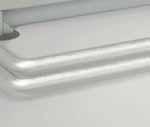


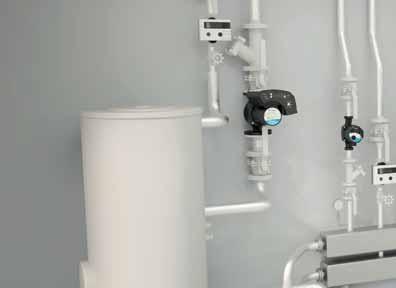










































































www.xylem.com
Hot & cold water circulation drainage removal Energy optimisation, monitoring & control Heat & cooling water treatments Thermal energy metering Digital services
New Aquarea L Generation heat pump



R290
NATURAL REFRIGERANT
A revolution in design, efficiency, connectivity and sustainability.
Year-round comfort
Aquarea heat pumps provide heating, cooling and hot water for the whole house.
Green future
Aquarea L Generation air to water heat pump is engineered with natural refrigerant R290 with GWP 3.
High performance Innovative hydraulic split heat pump, with 75 °C water outlet down to -10 °C outside, and operation down to -25 °C.
Harmony at home Compact design blends into indoor and outdoor spaces. The heat pump’s quiet operation brings harmony between technology and the home.

Smart control
Wi-Fi included for smart control, advanced monitoring and servicing.



























































 Sue Arundale, Director General EFCA.
Sue Arundale, Director General EFCA.






























































































































































 PAT LEHANE
PAT LEHANE




























































































